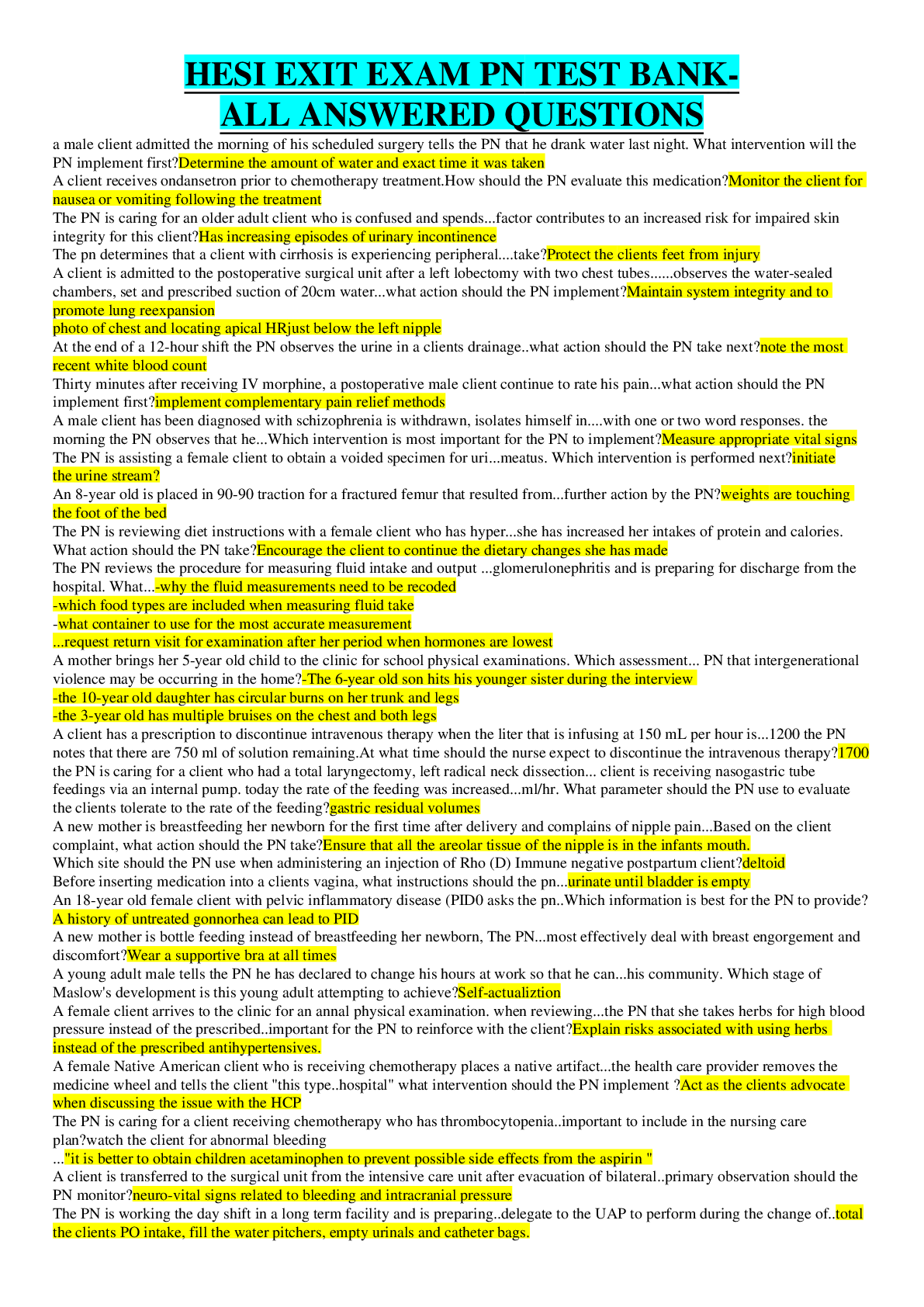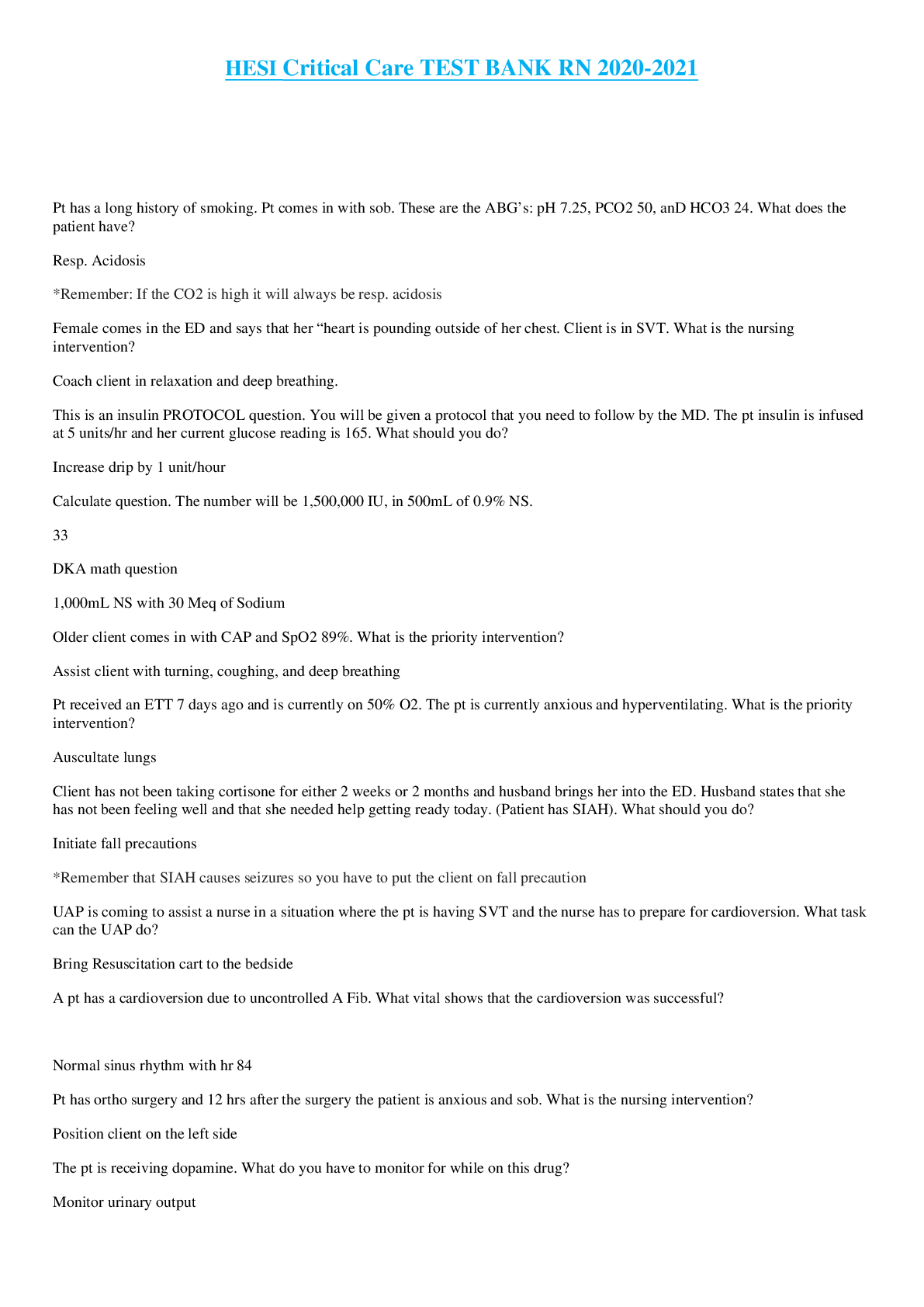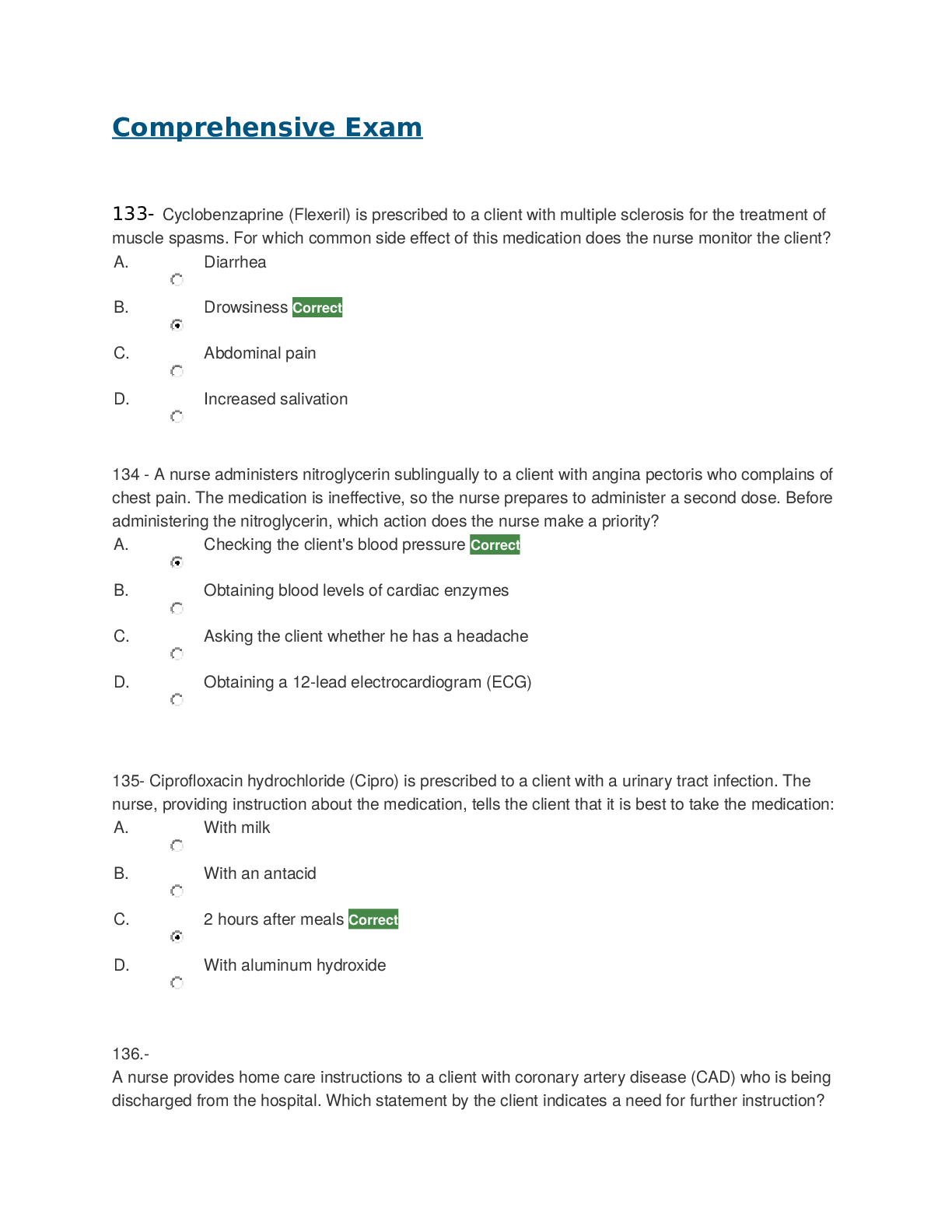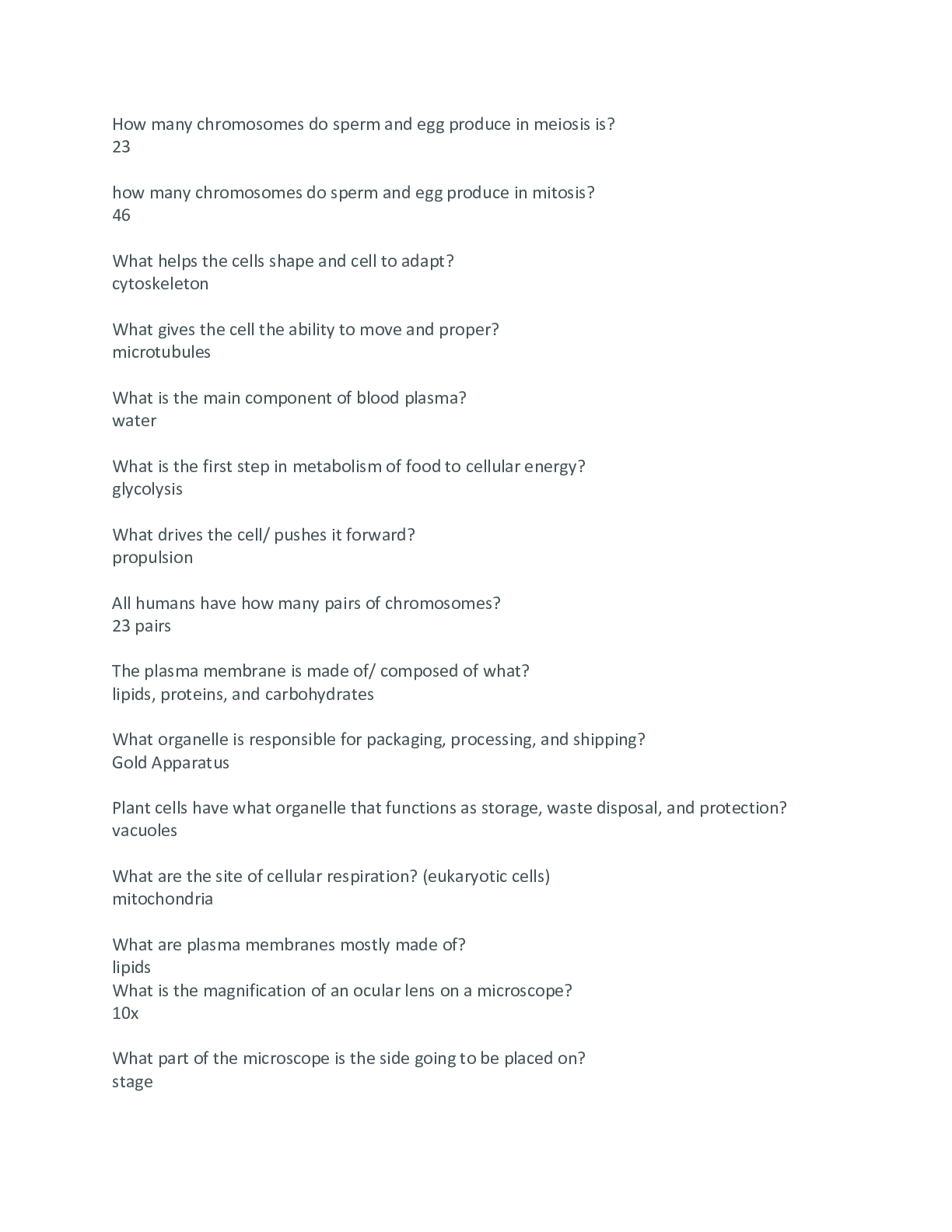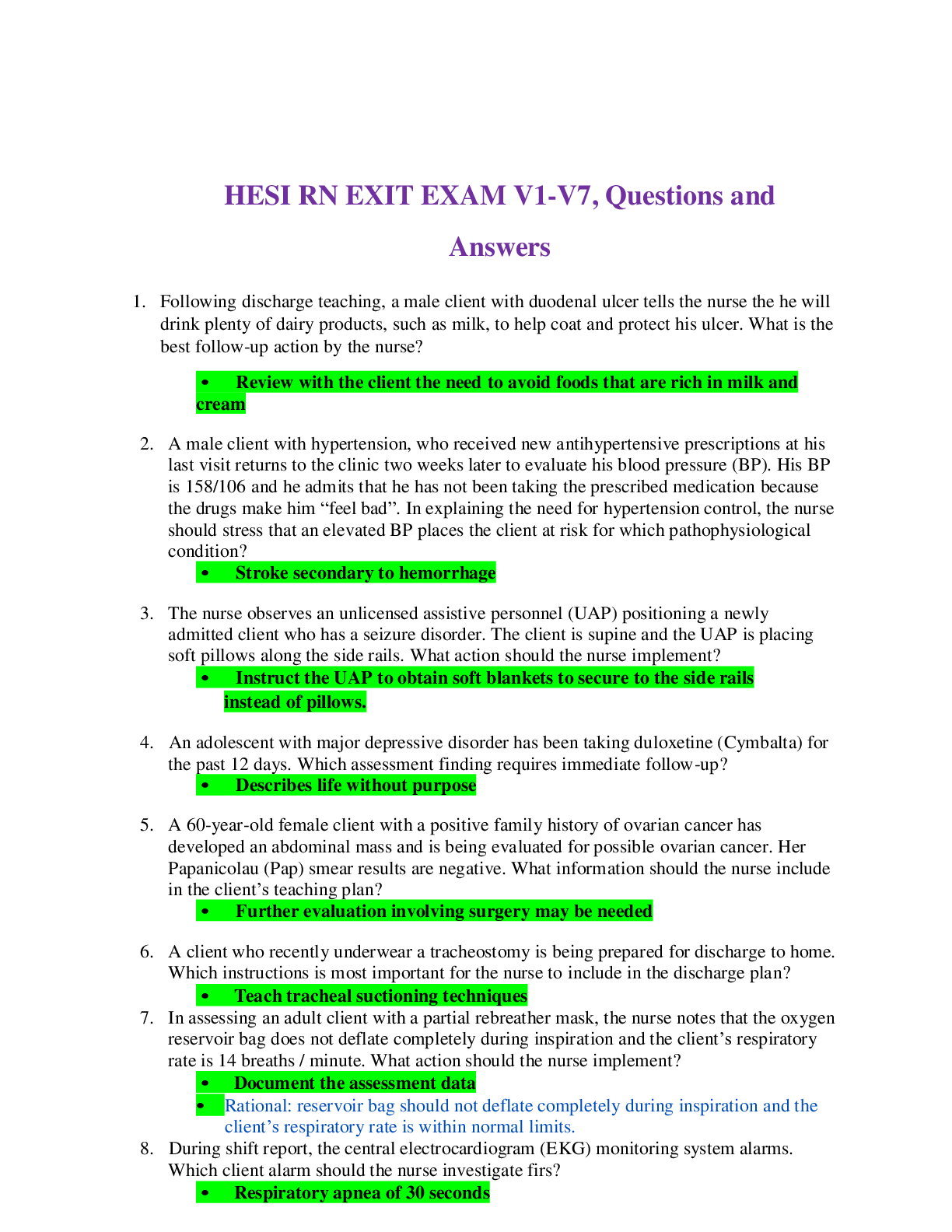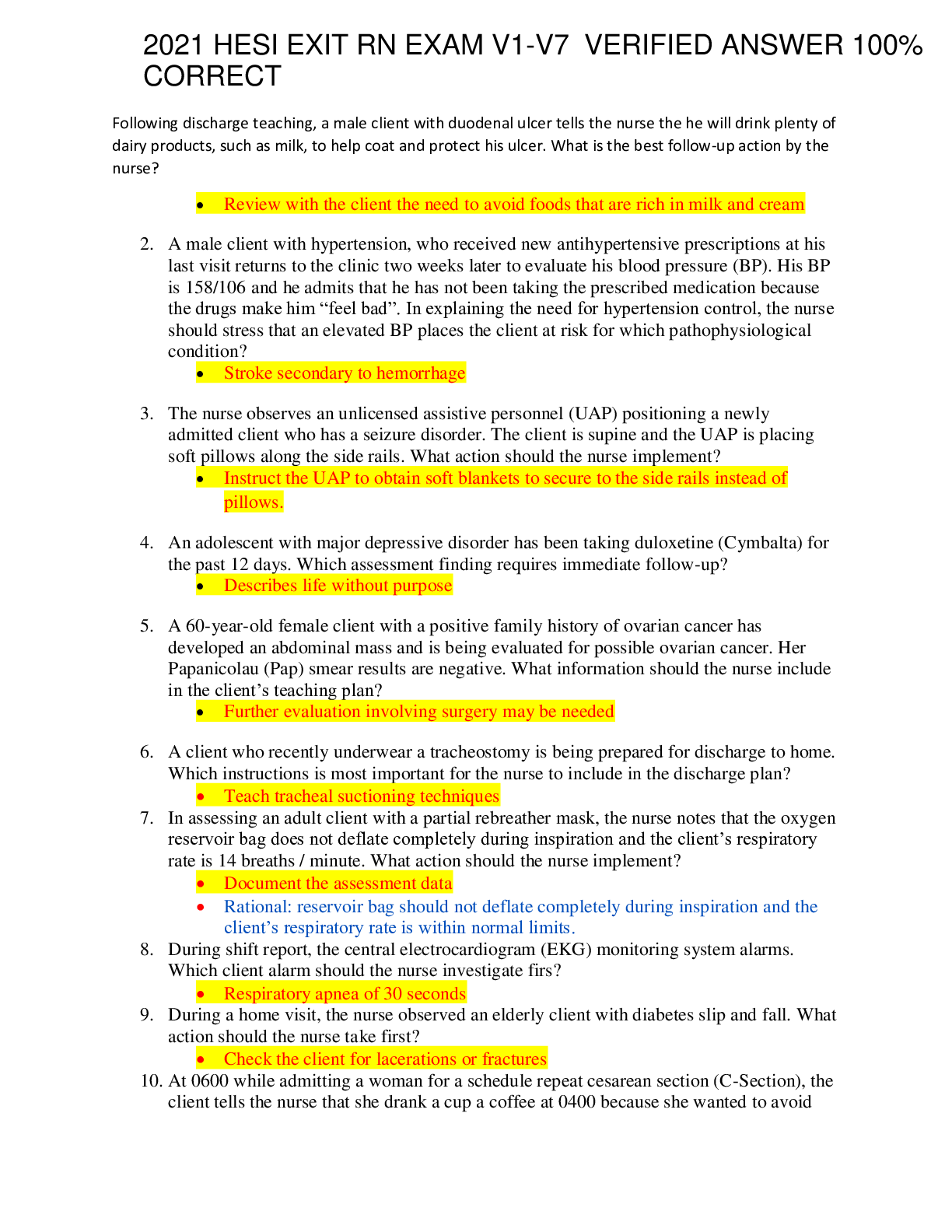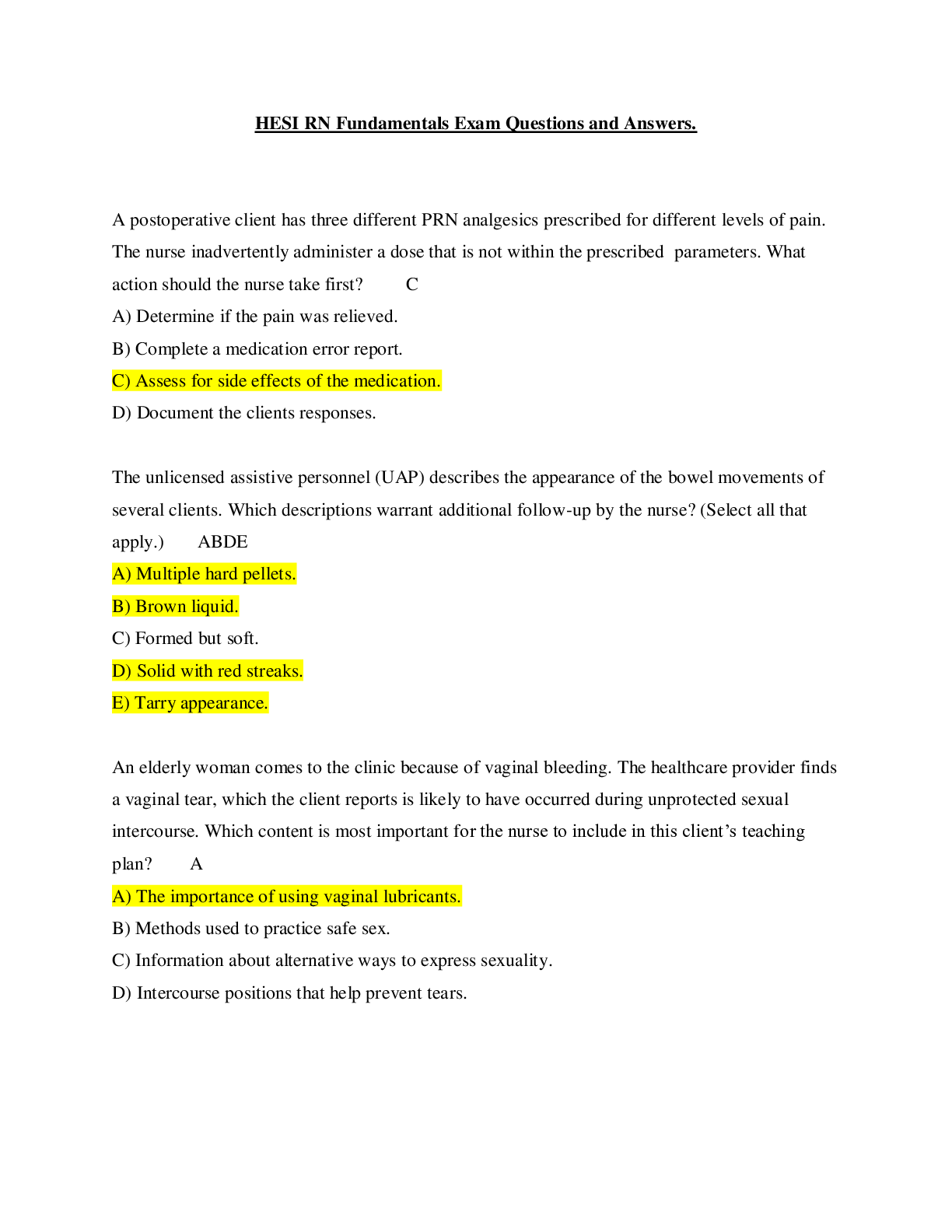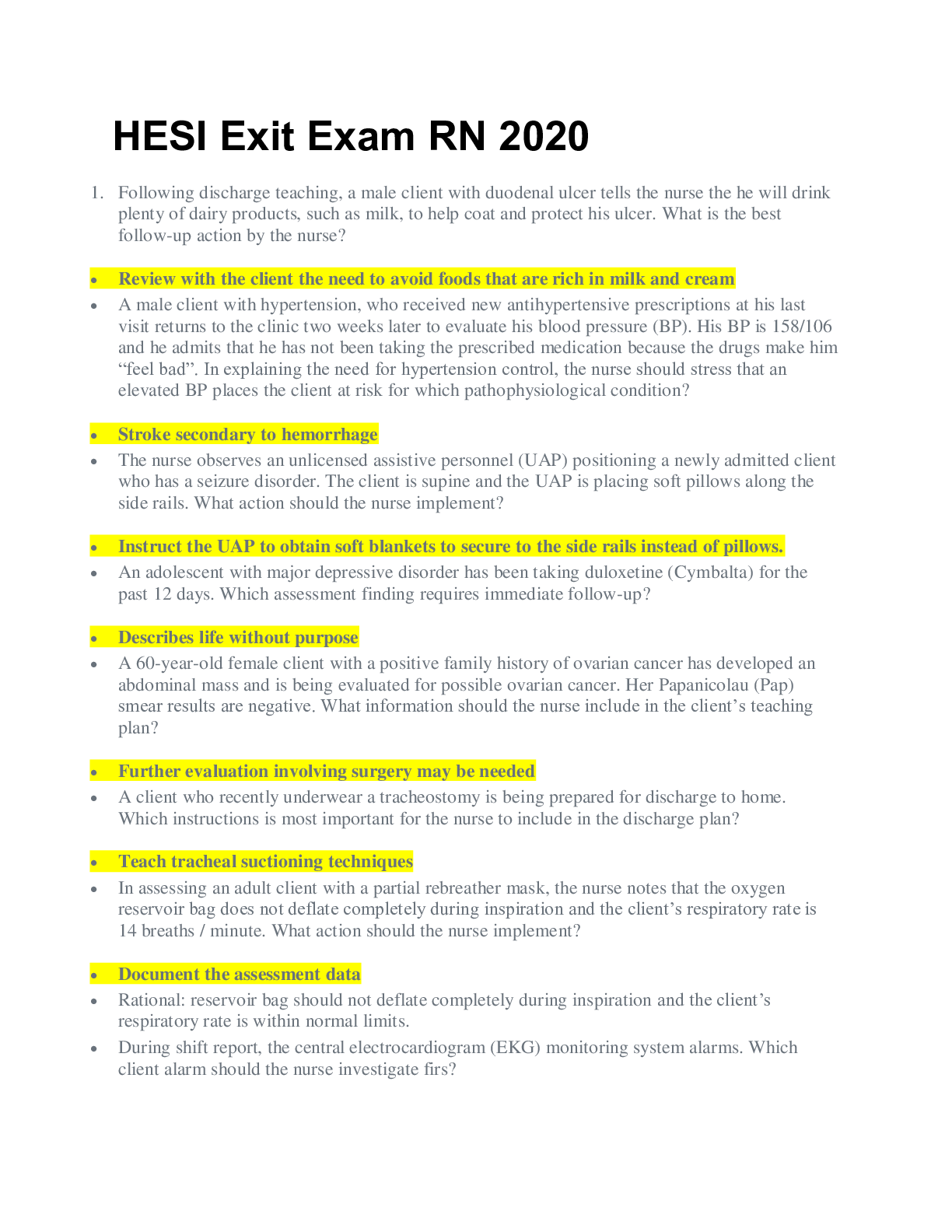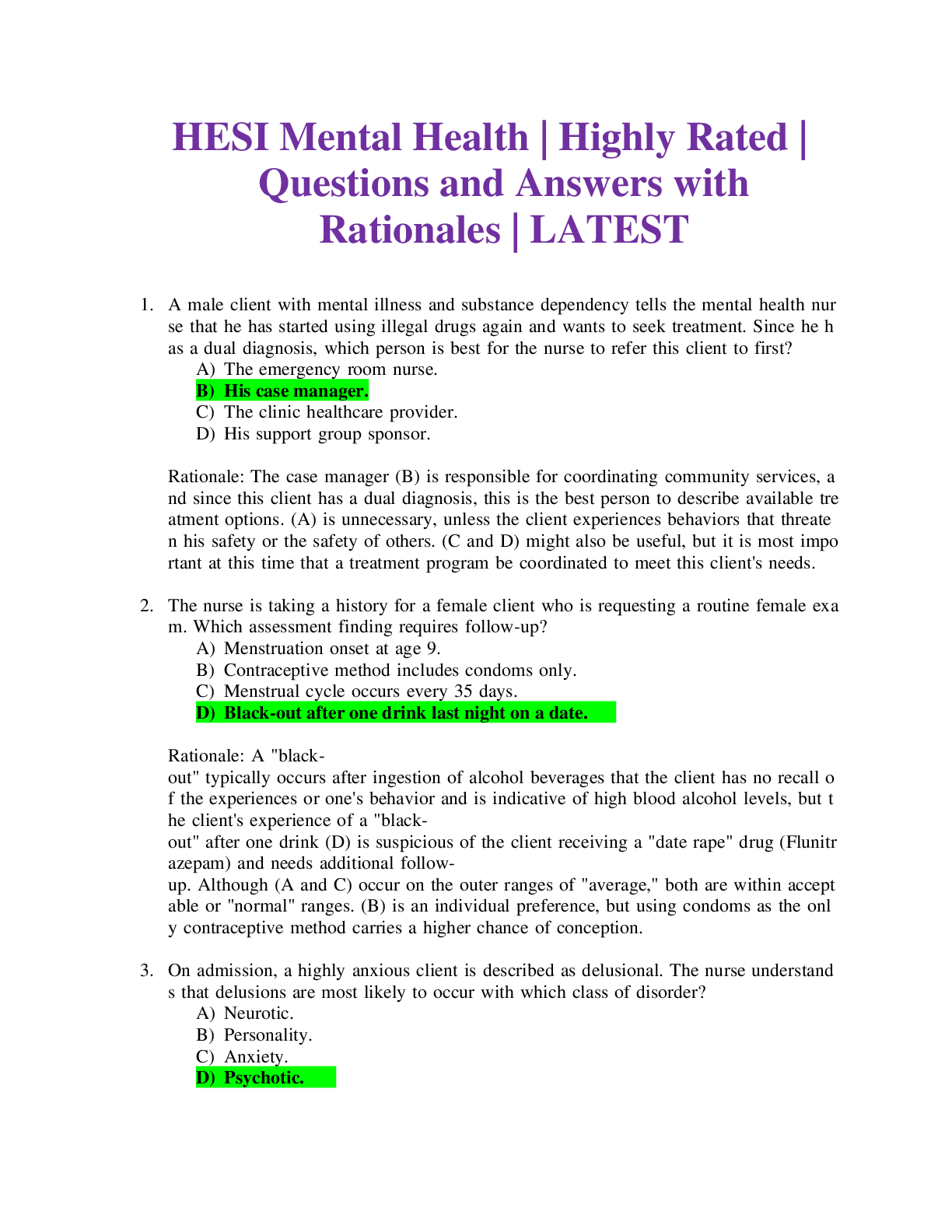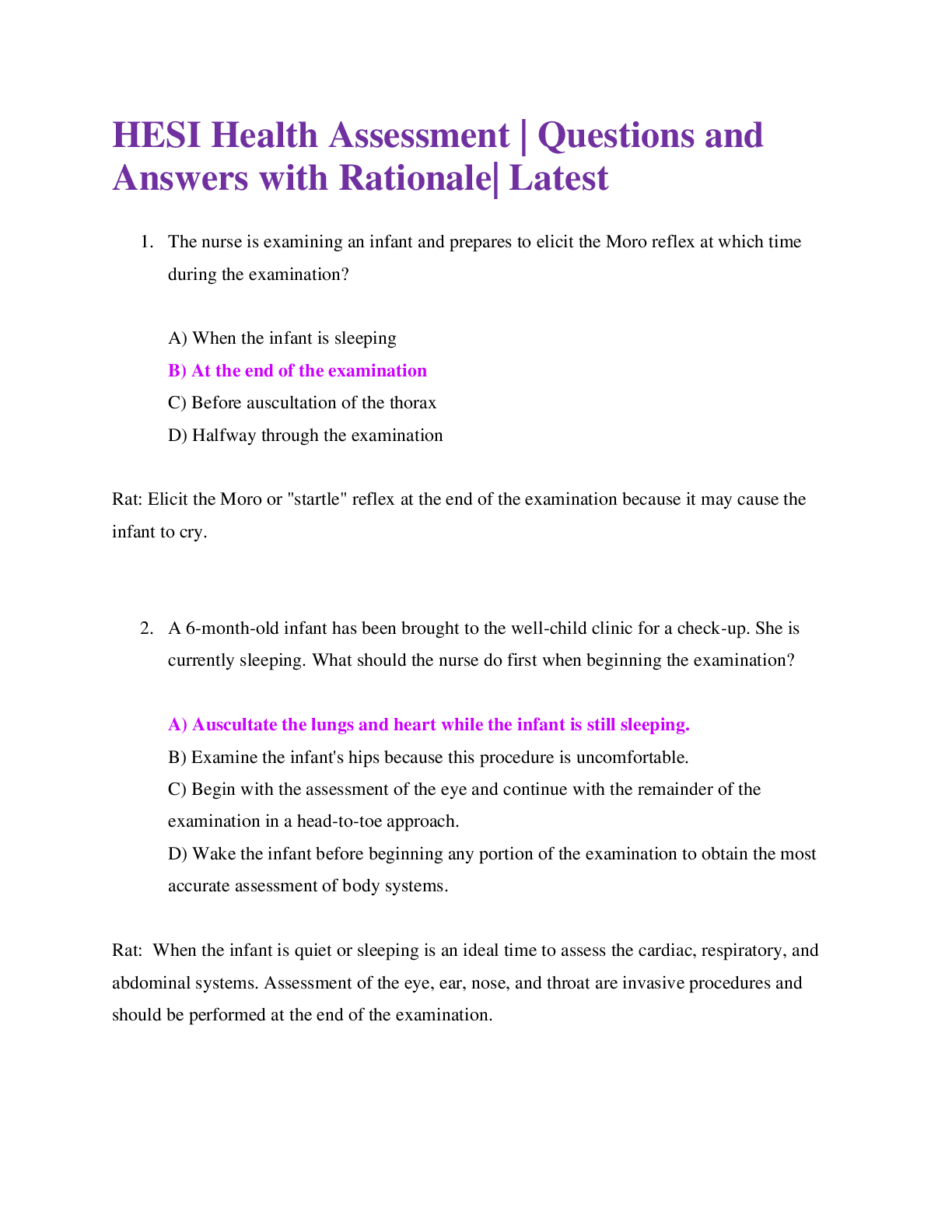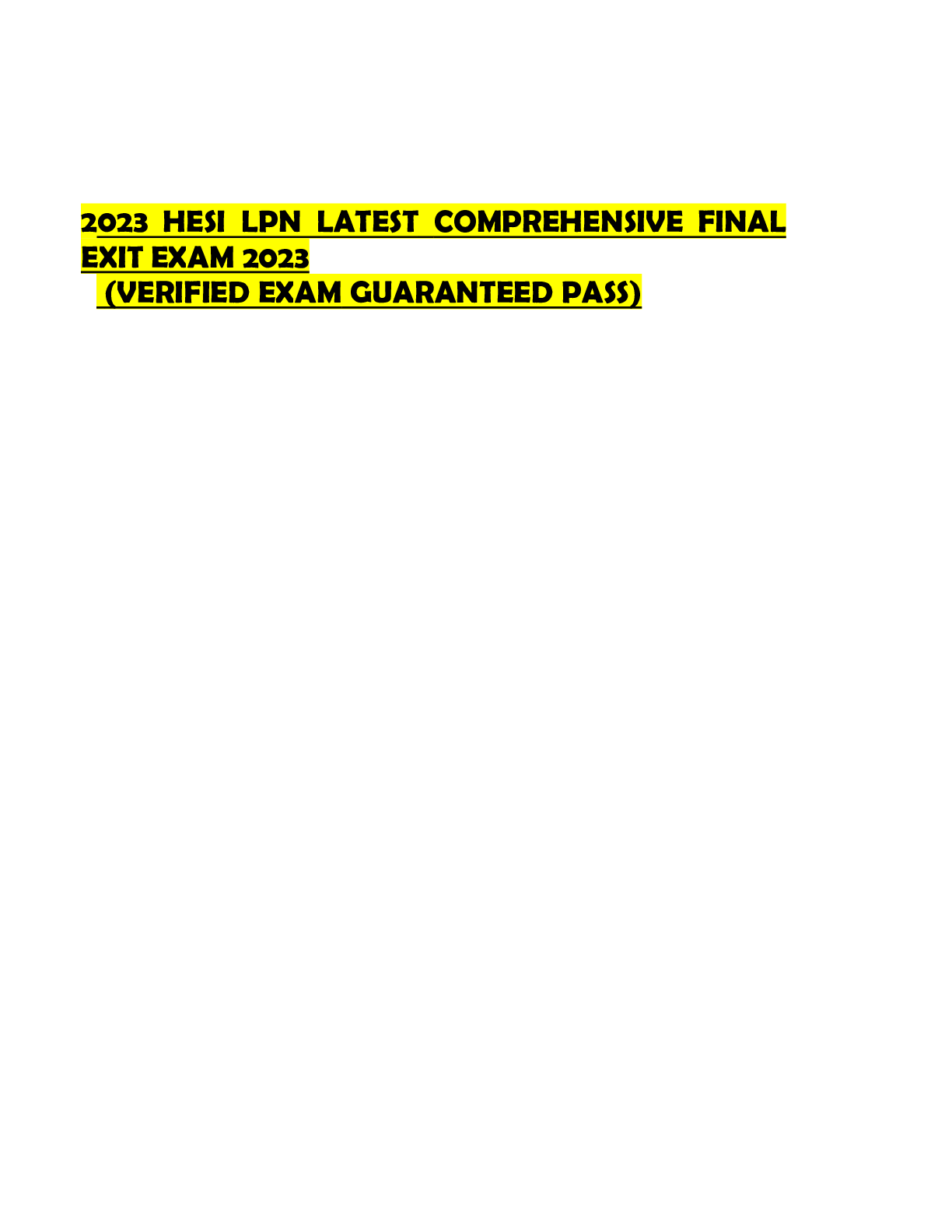*NURSING > HESI > HESI A2_Chemistry V1/V2 and entrance examContains 150 most tested Q&A -Includes explanations. See de (All)
HESI A2_Chemistry V1/V2 and entrance examContains 150 most tested Q&A -Includes explanations. See description for the listed question.
Document Content and Description Below
HESI A2 Chemistry V1/V2 1. What are all metric measurements composed of? A. Metric prefix and a basic unit of measure B. A significand and a metric prefix C. A metric prefix and a coefficient D... . A coefficient and a significand 2. What is the most commonly used temperature scale in the scientific community? A. Fahrenheit B. Celsius or Centigrade C. Kelvin D. English temperature method 3. The nucleus of an atom contains or is made up of which of the following? A. Protons and electrons B. Protons only C. Protons and neutrons D. Neutrons and electrons 4. What is an atom that has a positive charge called? A. A cathode B. A cation C. An anode D. An anion 5. In the periodic table, what are the rows called? A. Groups B. Moles C. Columns D. Periods 6. What is the atomic number? A. Number of neutrons B. Number of protons C. Number of electrons D. Number of isotopes 7. Which of the following describes the atomic mass? A. Mass of protons and electrons B. Mass of neutrons and electrons C. Average mass of that element’s isotopes D. Number of moles in a solution 8. Chemical equations are written in which manner? A. Product → Reactants B. Reactants → Products C. Reactants + Reactants D. Products + Reactants 9. What is the charge on potassium in the compound KCl? A. −1 B. +1 C. −2 D. +2 10. A catalyst is a substance that accelerates a reaction by which of the following? A. Adding energy to the overall reaction B. Increasing the amount of energy needed for the reaction to occur C. Finding an alternate pathway for a reaction that requires less energy D. Speeding up the overall reaction process 11. Percent concentration of a solution is expressed as which of the following? A. 100 parts per 100 dL B. Parts per 100 parts C. Parts of moles D. Moles per 100 parts 12. What will one liter of a one molar solution of any element contain? A. The atomic mass in grams of that element B. The atomic number in grams of that element C. The atomic mass in liters of that element D. The atomic number in liters of that element 13. Chemical bonding is the bonding of which of the following? A. One atom to another atom B. One mole to another mole C. A proton to an electron D. One cation to another cation 14. Which of the following describes an ionic bond? A. It shares electrons. B. It does not share electrons. C. It is sometimes called a covalent bond. D. It is the strongest of all chemical bonds. 15. The reaction 2C2H6 + 7O2 → 4CO2 + 6H2O has a ratio of 2 parts ethane (C2H6) and 7 parts oxygen (O2). How many parts of ethane (C2H6) will be needed to react with 21 parts of oxygen (O2)? A. 3 parts of ethane C2H6 B. 6 parts of ethane C2H6 C. 9 parts of ethane C2H6 D. 14 parts of ethane C2H6 16. What is the concentration of 58.5 g of NaCl in 2 L of solution (atomic weights of each element are as follows: Na = 23 g/mol, Cl = 35.5 g/mol)? A. 0.5 mol NaCl B. 0.75 mol NaCl C. 1 mol NaCl D. 2 mol NaCl 17. In a redox reaction, which of the following describes reduction? A. It is the loss of electrons. B. It is the gain of protons. C. It is the loss of a neutron. D. It is the gain of electrons. 18. What are acids? A. Hydrogen acceptors B. Solutions of high pH C. Hydrogen donors D. Amphoteric 19. What is a benefit of water’s ability to make hydrogen bonds? A. Lack of cohesiveness B. Low surface tension C. Use as a nonpolar solvent D. High specific heat 20. What are bases or alkaline solutions? A. Hydrogen acceptors B. Solutions of low pH C. Hydrogen donors D. Amphoteric 21. Chemical reactions in living systems proceed along catabolic pathways, and there tends to be an increase in which of the following? A. Entropy B. Enthalpy C. Glucose D. Glycogen 22. What is a pH of 7? A. Acidic B. Basic C. Neutral D. Positive 23. Which is the correct way to write Iodine (I) with an atomic mass of 131? A. I131 B. I131 C. 131I D. 131I 24. What is the correct formula for magnesium chloride? A. MgCl2 B. MgCl C. Mg2Cl D. Mg2Cl2 25. What is the weakest of all the intermolecular forces? A. Dispersion B. Dipole interactions C. Hydrogen bonding D. Covalent bonding 26. Beta radiation is the emission of which of the following? A. Large numbers of helium ions B. An electron C. High energy electromagnetic radiation D. A product of the decomposition of a proton 27. Which of the following describes carbohydrates? A. They serve as fuel for the body. B. They are present in DNA but not in RNA. C. They are the least abundant biomolecule. D. They cannot be stored in the body. 28. What are monosaccharides? A. The simplest form of carbohydrates B. The most complex form of carbohydrates C. One form of a very complex fat D. Artificial sweeteners such as saccharin 29. Disaccharides are the joining together of which of the following? A. Three to six monosaccharides B. Two monosaccharides C. A number of monosaccharides D. A fat and a monosaccharide 30. Glycolysis is one of the body’s chemical pathways for which of the following? A. Manufacturing glycogen B. Building proteins C. Producing fats D. Metabolizing glucose 31. Amino acids are the building blocks for which of the following? A. Nucleic acids B. Carbohydrates C. Proteins D. Lipids 32. What is the union of two amino acids using a peptide bond called? A. A dipeptide B. A peptide C. A monopeptide D. A polypeptide 33. Which of the following describes lipids? A. They are a major source of fuel for the body immediately after a meal. B. They are stored for a source of fuel after carbohydrate depletion. C. They are comprised of glycerol and three fatty acids. D. They are metabolized by a pathway called glycolysis. 34. Which of the following describes DNA? A. It is made of two strands of a ribose sugar-phosphate chain. B. It consists of two strands of a deoxyribose sugar-phosphate chain. C. It consists of one strand of a ribose sugar-phosphate chain. D. It is located solely in the mitochondria of individual cells. 35. Use of the periodic table allows prediction of which of the following? A. The properties of each of the elements B. The charge of polyatomic ions C. The number of isotopes in each element D. The potential for discovery of new elements 36. How could water be boiled at room temperature? A. By lowering the pressure B. By increasing the pressure C. By decreasing the volume D. By raising the boiling point 37. What is a combustion reaction? A. It is endothermic. B. It substitutes one element for another. C. It always shares electrons. D. It is a reaction that involves oxygen. 38. What is KCl → K + Cl2 an example of? A. Synthesis B. Decomposition C. Single replacement D. Double replacement 39. Iodine and carbon dioxide undergo sublimation at room temperature and atmospheric pressure. What is this process? A. Changing from a gas to a solid B. Changing from a liquid to a gas C. Changing from a solid to a liquid D. Changing from a solid to a gas 40. An experiment is performed to measure the temperature of boiling water at sea level. The actual boiling point is 104.6° C, 104.5° C, and 104.4° C. What term best describes these data? A. Accurate B. Precise C. Variable D. Equivalent Chemistry Questions with Answers and Explanations 1. Which of the following substances allows for the fastest diffusion? A. gas B. solid C. liquid D. plasma 2. What is the oxidation number of hydrogen in CaH2? A. +1 B. 1 C. 0 D. +2 3. Which of the following does not exist as a diatomic molecule? A. boron B. fluorine C. oxygen D. nitrogen 4. What is another name for aqueous HI? A. hydroiodate acid B. hydrogen monoiodide C. hydrogen iodide D. hydriodic acid 5. Which of the following could be an empirical formula? A. C4H8 B. C2H6 C. CH D. C3H6 6. What is the name for the reactant that is entirely consumed by the reaction? A. limiting reactant B. reducing agent C. reaction intermediate D. reagent 7. What is the name for the horizontal rows of the periodic table? A. groups B. periods C. families D. sets 8. What is the mass (in grams) of 7.35 mol water? A. 10.7 g B. 18 g C. 132 g D. 180.6 g 9. Which of the following orbitals is the last to fill? A. 1s B. 3s C. 4p D. 6s 10. What is the name of the binary molecular compound NO5? A. nitro pentoxide B. ammonium pentoxide C. nitrogen pentoxide D. pentnitrogen oxide 11. What is the mass (in grams) of 1.0 mol oxygen gas? A. 12 g B. 16 g C. 28 g D. 32 g 12. Which kind of radiation has no charge? A. beta B. alpha C. delta D. gamma 13. What is the name of the state in which forward and reverse chemical reactions are occurring at the same rate? A. equilibrium B. constancy C. stability D. toxicity 14. What is 119°K in degrees Celsius? A. 32°C B. –154°C C. 154°C D. –32°C 15. What is the SI unit of energy? A. ohm B. joule C. henry D. newton 16. What is the name of the device that separates gaseous ions by their mass-to-charge ratio? A. mass spectrometer B. interferometer C. magnetometer D. capacitance meter 17. Which material has the smallest specific heat? A. water B. wood C. aluminum D. glass 18. What is the name for a reaction in which electrons are transferred from one atom to another? A. combustion reaction B. synthesis reaction C. redox reaction D. double-displacement reaction 19. What are van der Waals forces? A. the weak forces of attraction between two molecules B. the strong forces of attraction between two molecules C. hydrogen bonds D. conjugal bonds 20. Which of the following gases effuses the fastest? A. Cl2 B. O2 C. N2 D. H2 21. Which of the following elements is not involved in many hydrogen bonds? A. fluorine B. carbon C. oxygen D. nitrogen 22. What is the mass (in grams) of 0.350 mol copper? A. 12.5 g B. 14.6 g C. 18.5 g D. 22.2 g 23. How many d orbitals are there in a d subshell? A. 5 B. 7 C. 9 D. 11 24. What is the name for the number of protons in an atom? A. atomic identity B. atomic mass C. atomic weight D. atomic number 25. Which of the following elements is an alkali metal? A. magnesium B. rubidium C. hydrogen D. chlorine Chemistry note cards for HESI entrance exam Question Matter that has a definite shape and volume Matter that changes in volume with changes in temperature and pressure A change of matter is when no change is made to the chemical composition of a substance. Simplest of substances and is represented by a letter or letters Law that states matter can neither be created nor destroyed during a chemical reaction The breaking of bonds and reforming of new bonds to create new chemical compounds with different chemical formulas and different chemical properties 5 main chemical reactions Chemical reaction in which 2 elements combine to form a product Chemical reaction that is the breaking of a compound into component parts The chemical reaction that is the reaction of a compound with oxygen Chemical reaction that consists of an active metal reaction with an ionic compound creating a new compound Chemical reaction involving 2 ionic compounds; the reactant yields "switched partners" how elements are arranged on the periodic table Number that represents the # of protons an element has average of the masses of each of its isotopes as they occur in nature Mass number - atomic number = Columns of the periodic table = Rows of the periodic table = Group IA = charge Group IIA = charge Group IIIA = charge Group VA = charge Group VIA = charge Group VIIA = charge Charge of noble gases Positively charged ions Negatively charged ions Neutral ions # of proteins in an element = proteins + neutrons = In reactions, atoms try to reach stable electron configurations. reactions take place in the nucleus, to obtain stable nuclear configurations. Word used to describe the emission of particles from an unstable nucleus. The particles that are emitted during radioactivity 3 types of radiation Radiation that is the emission of helium ions Alpha radiation particles have a charge of How can penetration from alpha particles be stopped? Radiation that is a product of the decomposition of a neutron. It is composed of high-speed, high- energy electrons. How can beta radiation particles be stopped? radiation is high-energy electromagnetic radiation that lacks charge and mass. What radiation can be stopped by several feet of concrete or several inches of lead? 2 types of chemical bonding What bond is an electrostatic attraction between 2 oppositely charged ions? (between metals & nonmetals) A single bond is formed when 2 atoms share a pair of electrons. A bond is formed when 2 electron pairs are shared. A bond is formed when 3 electron pairs are shared. What is the strongest type of chemical bond? What is it formed by? In a covalent bond compound, if the electrons are shared equally, then the bond is . If electrons are not shared equally in a covalent bond, the bond is . is based on the difference in electronegativity values for the elements involved Hydrogen bonding, dipole interactions and dispersion forces. Bond that is the attraction for a hydrogen atom by a highly electronegative element. Elements fluorine, chlorine, oxygen and nitrogen are generally involved in a bond. Bond that is the strongest of the intermolecular forces The attractions of one dipole for another A is created when an electron pair in a covalent bond is shared unequally A dipole attraction is a _ intermolecular force. The weakest of all intermolecular forces. Dispersion forces are typically found in covalent compounds. 6.02 x 10^23 is a The mass of one mole of a substance The part of chemistry that deals with the quantities and numeric relationships between compounds in a chemical reaction. To balance an equation, are placed in front of each component. 4 ways to increase the reaction rate Increasing the causes the particles to have greater kinetic energy, allowing them to move faster and have a greater chance Accelerates a reaction by reducing the activation energy, or the amount of energy needed for a reaction to occur. reaction involve the transfer of electrons from one element to another The loss of electrons The gain of electrons Sum of oxidation #'s = Compounds acting as hydrogen-ion donors Compounds acting a hydrogen-ion acceptor pH value less that 7.0; taste sour/tart; produce h30+ (most of their formulas begin with H) Produce OH-; taste is bitter, feels slippery; conduct electricity; formulas contain OH-, pH value is greater than 7.0 What characterizes a chemical reaction as combustion? What is the change of potassium in KCl? How many electrons does an oxygen ion have How many neutrons does an atom of carbon -14 contain? What is the strongest type of chemical bond? What is the mass of one mole of CO2? How many moles are present in 2 moles of O2? What would be the oxidation state of the sulfur atom in sulfuric acid, H2SO4? CHEMISTRY V1/V2 (140 Questions and Answers)From test 1. If Hydrogen is in a compound, what would its oxidation number be? 2. What is the oxidation number of any simple ion? 3. How many kilograms are in a pound? 4. What is the temperature for freezing point of water in Celsius? 5. What is the conversion of Celsius to Fahrenheit? 6. What is the oxidation number of an element atom? 7. What is the freezing point of sea water in Fahrenheit? 8. How many amino acids are in a dipeptide? 9. If Oxygen is in a compound, what would its oxidation number be? 10. Which of the following pH values would lemon juice likely have? 11. What is a pentose? 12. What is the oxidation state of the Sulfur atom in Sulfuric Acid H2SO4? 13. How many neutrons does carbon 14 have? 14. How many protons does Potassium have? 15. How many amino acids are essential for human life? 16. Normal body temperature in °C? 17. Normal body temperature in °F? 18. Boiling point of water in °C? 19. Boiling point of water in °F? 20. 0°K is equal to °C? 21. The term Amphoteric means? 22. What is Kelvin based around? 23. A compound that is a Hydrogen or proton donor, corrosive to metals, causes blue litmus paper to become red and becomes less acidic when mixed with a base is? 24. Mixture of 2 or more metals are? 25. Acids: 26. 3 types of radiation in nuclear chemistry? 27. Alpha radiation: 28. Type of Alloy in which another metal is dissolved in Mercury (Hg)? 29. Proteins are made up of? 30. Glycogen is what kind of starch? 31. When an atom GAINS ONE or more electrons? 32. Basic building block of a molecule? 33. Atomic mass? 34. Atomic #: 35. Base? 36. Key note: 37. Beta radiation: 38. What is Biochemistry? 39. Fahrenheit is based off of? 40. How does ↑ Surface area speed up chemical reactions? 41. How do catalyst accelerate a chemical reaction? 42. What does COOH symbolize? 43. Which of the following is not a solution type? 44. Define Catalyst. 45. What is an atom called when it LOSES 1 or more electrons? 46. What is chemical bonding? 47. What is an Ionic bond? 48. Ionic bonding? 49. Single Covalent bond? 50. What are chemical reactions? 51. Double Covalent bond? 52. Triple Covalent bond? 53. The following is an example of? 54. What is a combustion reaction? 55. What is a compound? 56. Different types of solutions? 57. Strongest type of chemical bond? 58. What is a decomposition reaction? 59. What is Deoxyribose? 60. Attractions between opposite charges of polar moles? 61. What is a Disaccharide? 62. When 2 monosaccharides are joined together this makes? 63. Type of chemical bond that share 2 electron pairs? 64. Example of double replacement? 65. Example of Single replacement? 66. Group of electrons revolving around the nucleus of an atom, or known as a cloudlike group of electrons? 67. Mixtures of matter that readily separate such as water and oil? 68. 3 common temperature systems? 69. Celsius is based around? 70. What is oxidation? 71. What is reduction? 72. Gamma radiation: 73. Unit measure of weight? 74. Basic units of METRIC system? 75. What are Hydrogen bonds? 76. Examples of intermolecular forces? 77. 4 basic ways to speed up a reaction? 78. What are intermolecular forces? 79. Where are nucleic acids, DNA & RNA found? 80. Atoms of the same element but have different numbers of neutrons? 81. Gluconeogenesis is a process that produces? 82. A way to express concentration of atoms? 83. Part of the nucleus of an atom that has no charge? 84. What is the Molarity Formula? 85. Single sugar molecules? 86. How does ↑ concentration cause reaction acceleration? 87. Which is an example of a ionic bond? 88. In a covalent bond compound, if the electrons are shared equally, then the bond is? 89. The study of changes that occur in atomic nuclei? 90. Polar Covalent bond? 91. When 3-6 monosaccharides join together this is called? 92. Emission of particles or energy from an unstable nucleus? 93. Particles that are emitted during radioactivity? 94. Reactant is? 95. A substance that is dissolved in a solution? 96. A homogenous mixture of 2 or more substances? 97. Liquid substance capable of dissolving other substances? 98. Define stoichiometry. 99. Combining parts into a whole is? Or synthesis is? 100. How many electrons does an Oxygen ion have? 101. What is the charge of Potassium (K) in KCl? 102. What is the mass of 1 mole of CO2? 103. How many moles of atoms are present in 2 moles of O2? 104. What characterizes a chemical reaction as combustion? The chemical reaction that is the reaction of a compound with Oxygen? 105. Sum of oxidation # =? 106. Increasing the causes the particles to have greater kinetic energy, allowing them to move faster and have a greater chance of reacting. 107. To balance an equation, what is placed in front of each component? 108. Dispersions forces are found in which covalent bond? 109. The weakest of all intermolecular forces? 110. A Dipole attraction is a intermolecular force? 111. What is created when an electron pair in a covalent bond is shared unequally? 112. The attractions of one dipole to another is? 113. Strongest bond of intermolecular forces? 114. Elements Flourine (F), Chlorine (Cl ), Oxygen (O) and Nitrogen (N) are involved in which bond? 115. Polarity is? 116. What reactions take place in the nucleus to obtain stable nuclear configurations? 117. Mass # - Atomic # = 118. Protons + Neutrons = 119. # of Protons in an element = 120. Neutral subatomic particles = 121. – charge subatomic particles = 122. + charge subatomic particles = 123. Charge of noble gases? 0 124. Group IA = 125. Group IIA = 126. Group IIIA = 127. Group VA = 128. Group VIA = 129. Group VIIA = 130. Rows on periodic table: 131. Columns of periodic table: 132. How elements are arranged on the periodic table? 133. Matter that has definite shape & volume? 134. Matter that changes in volume with changes in temperature & pressure? 135. Which change of matter is when no change is made to the chemical composition of a substance? 136. Simplest substance and is represented by a letter or letters? 137. Law that states matter can neither be created nor destroyed during a chemical reaction (but it can change forms)? 138. Law that states energy can neither be created nor destroyed (but it can change forms)? 3- LI 4- BE 5 B 6- C N 7 0 8 F9 NE 10 11- NA 12- Mg 13- AL 14-SI 15-P 16-S 17-Cl 18-Ar K- 19 CA- 20 [Show More]
Last updated: 1 year ago
Preview 1 out of 44 pages
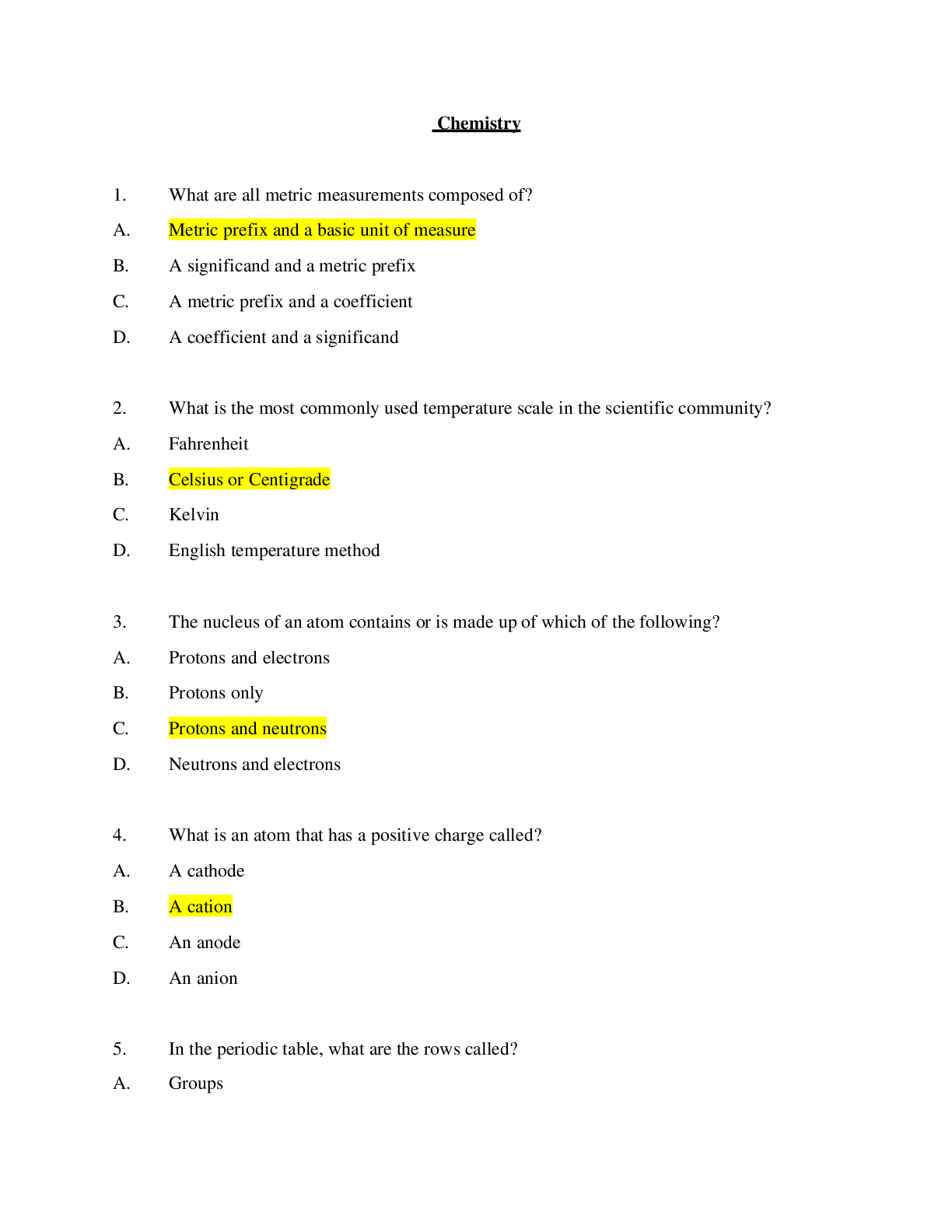
Reviews( 0 )
Document information
Connected school, study & course
About the document
Uploaded On
Apr 04, 2021
Number of pages
44
Written in
Additional information
This document has been written for:
Uploaded
Apr 04, 2021
Downloads
1
Views
72

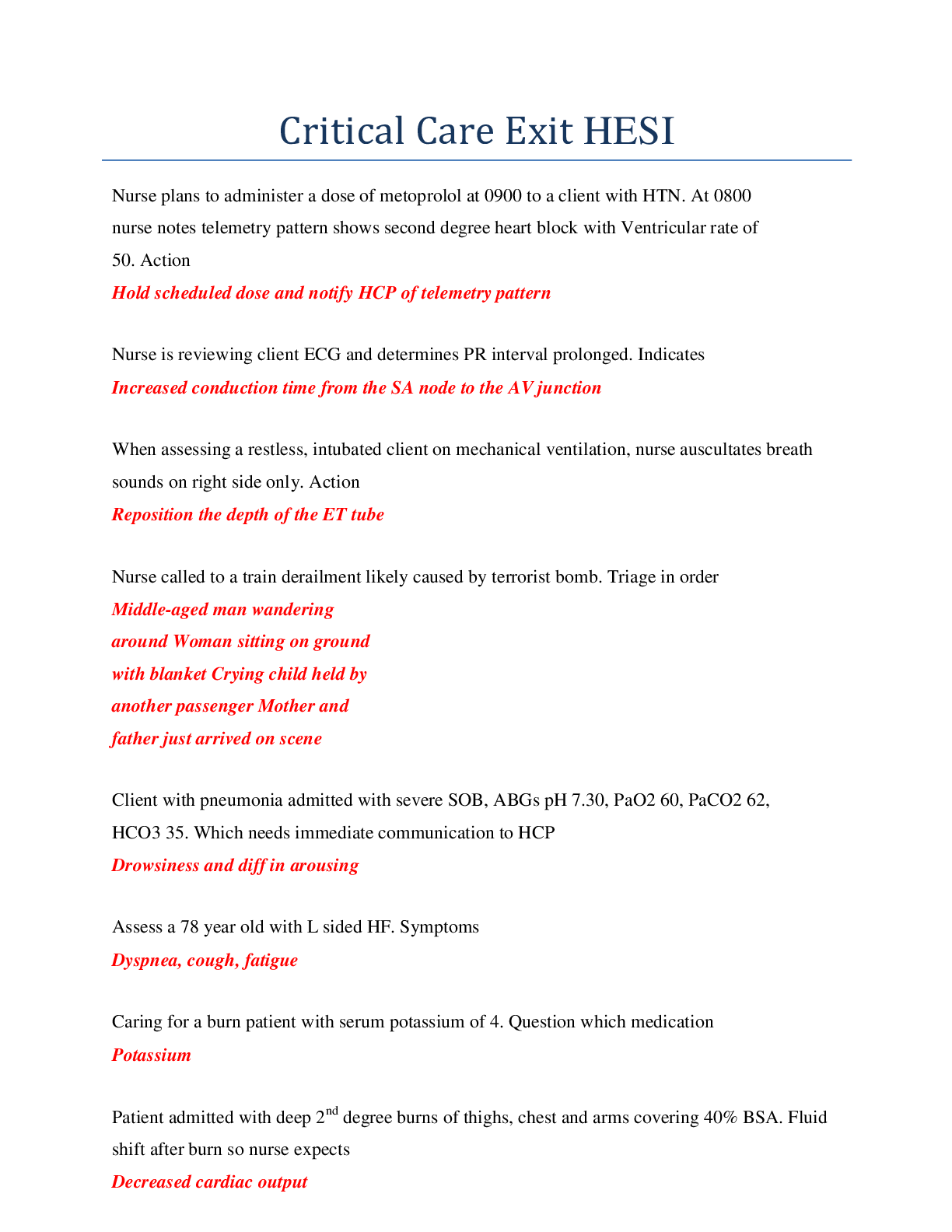
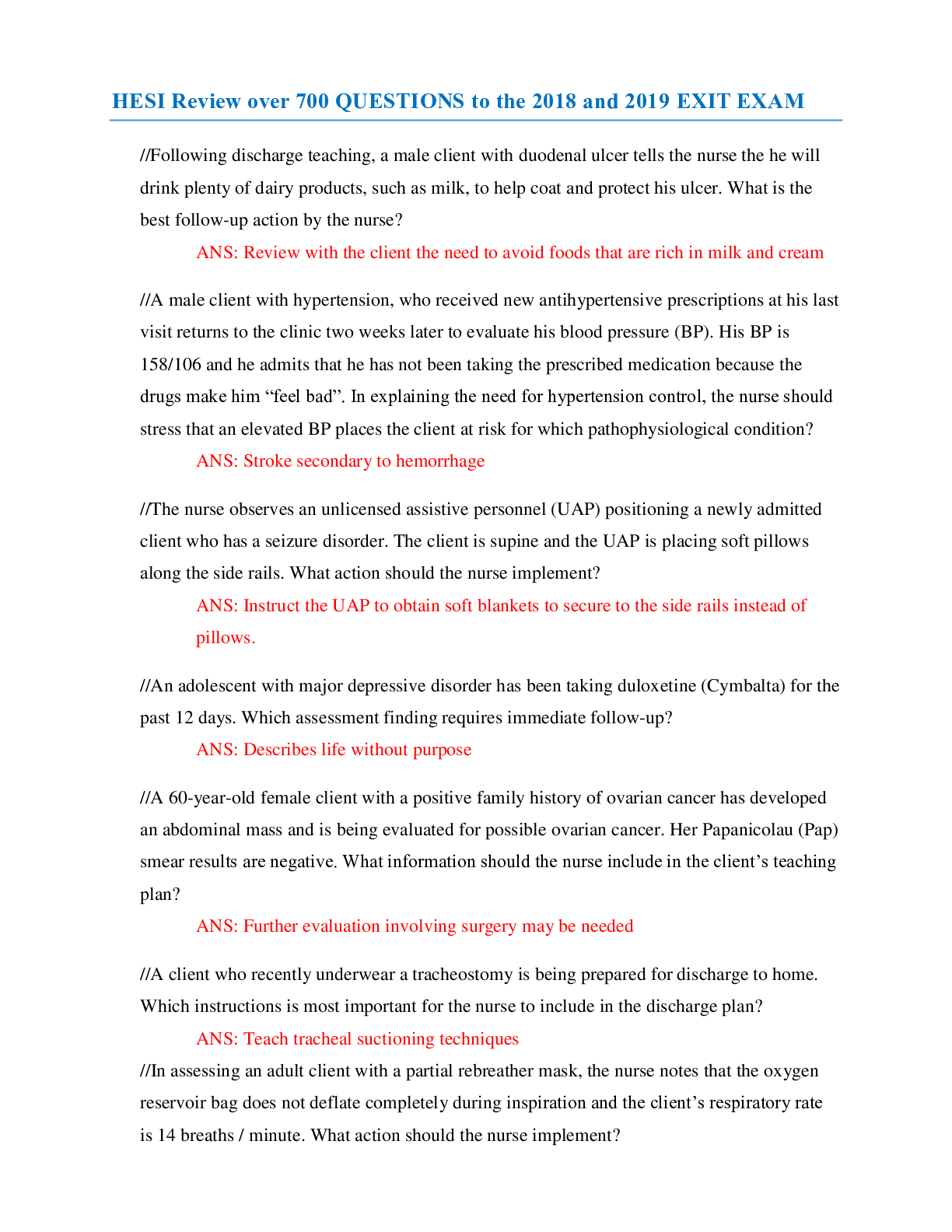
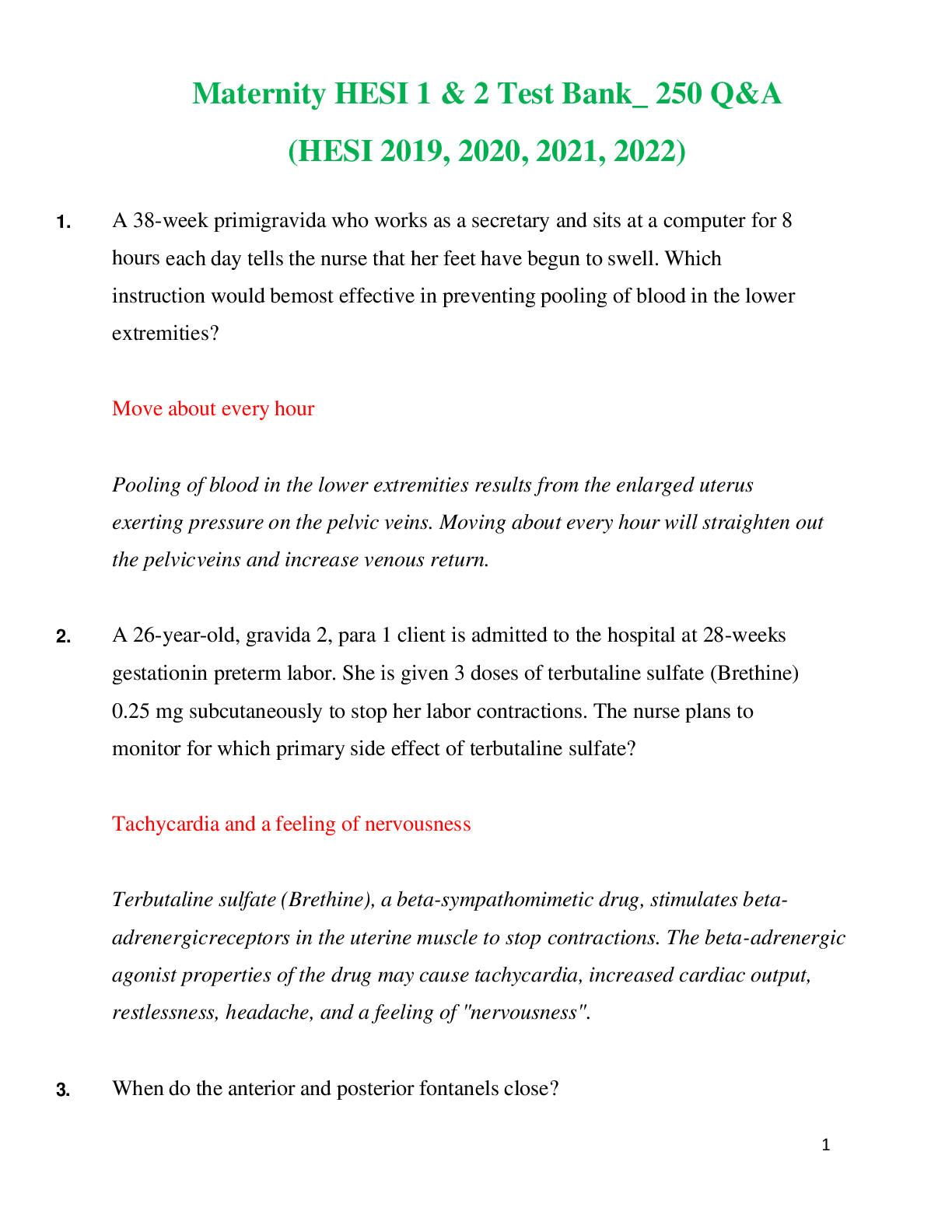
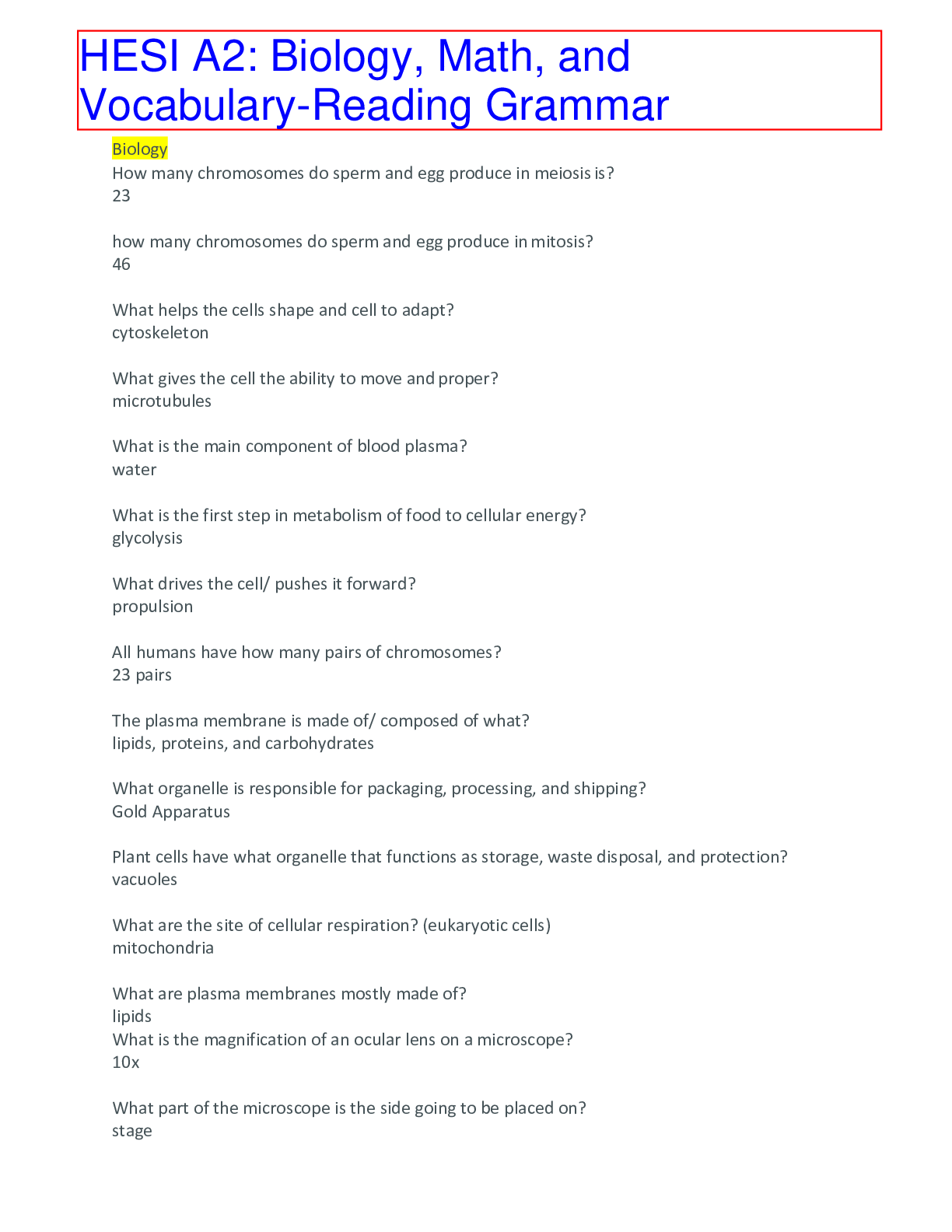
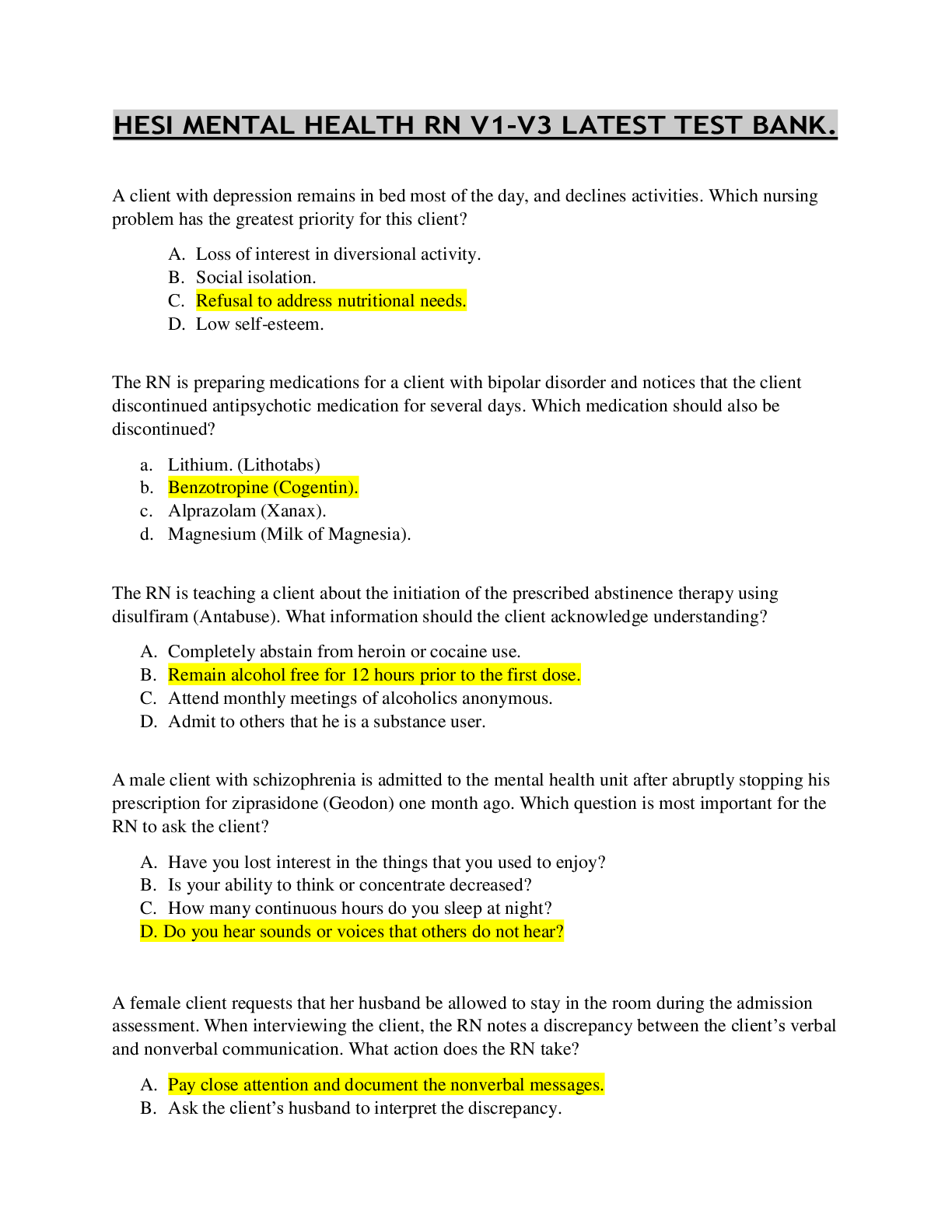
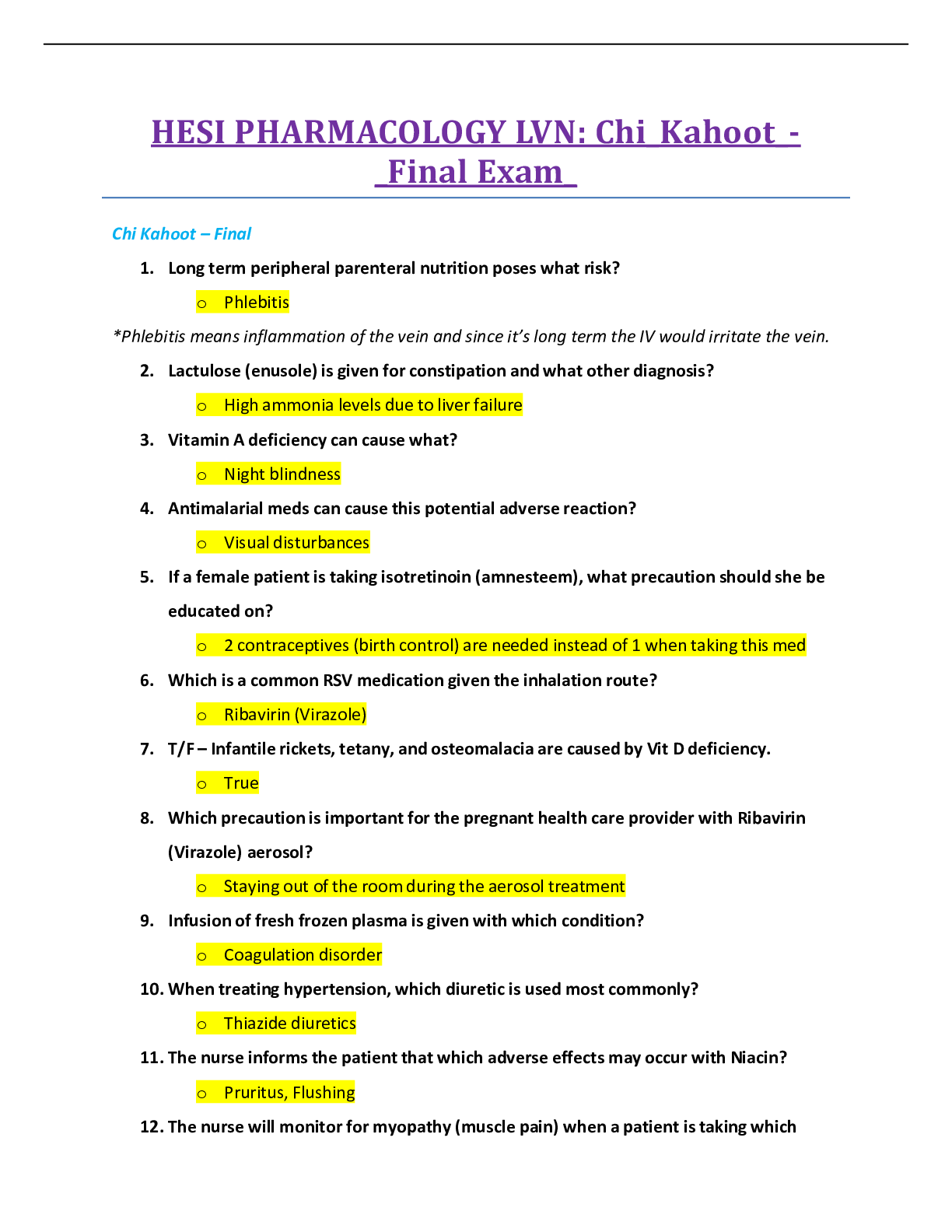
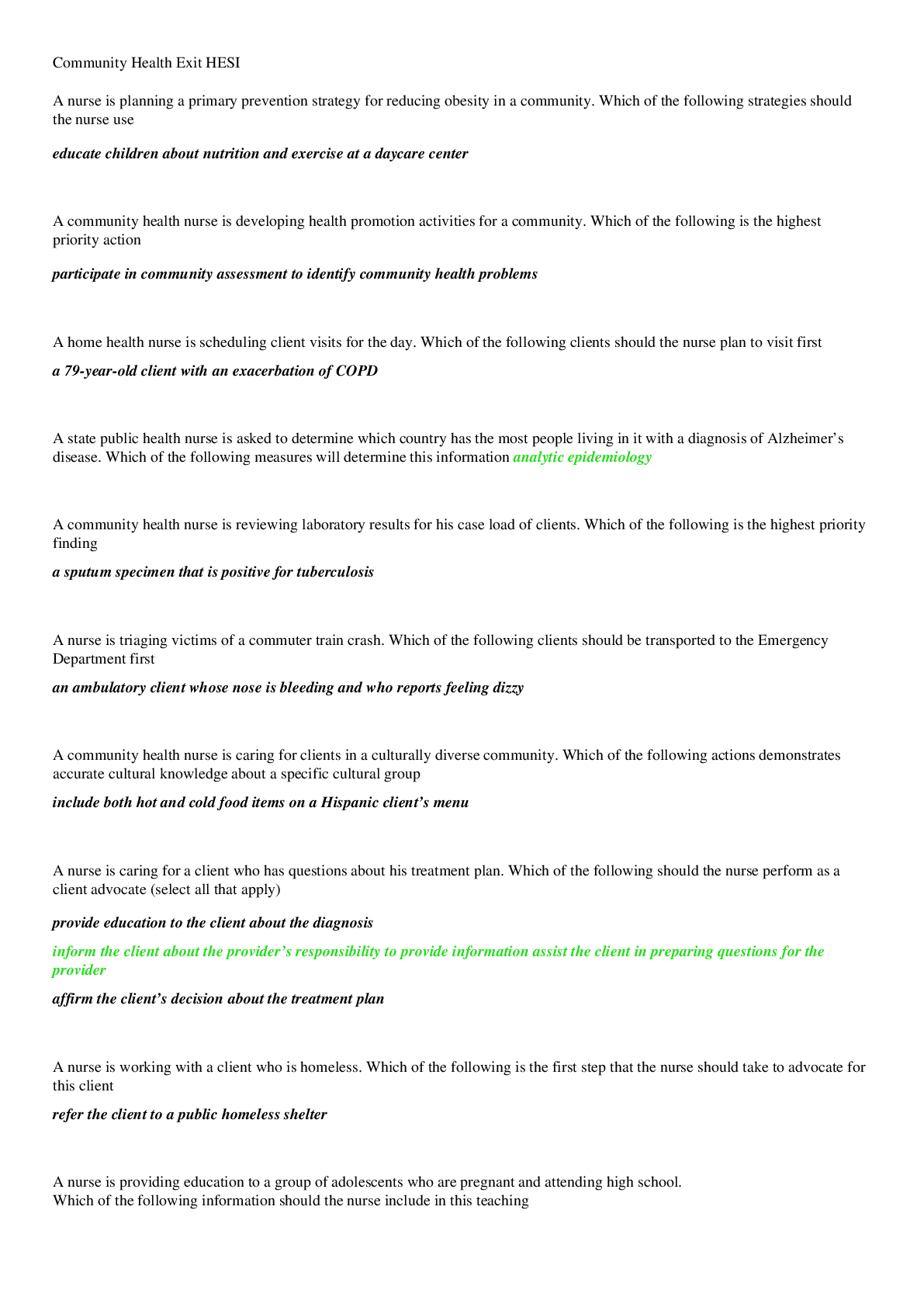
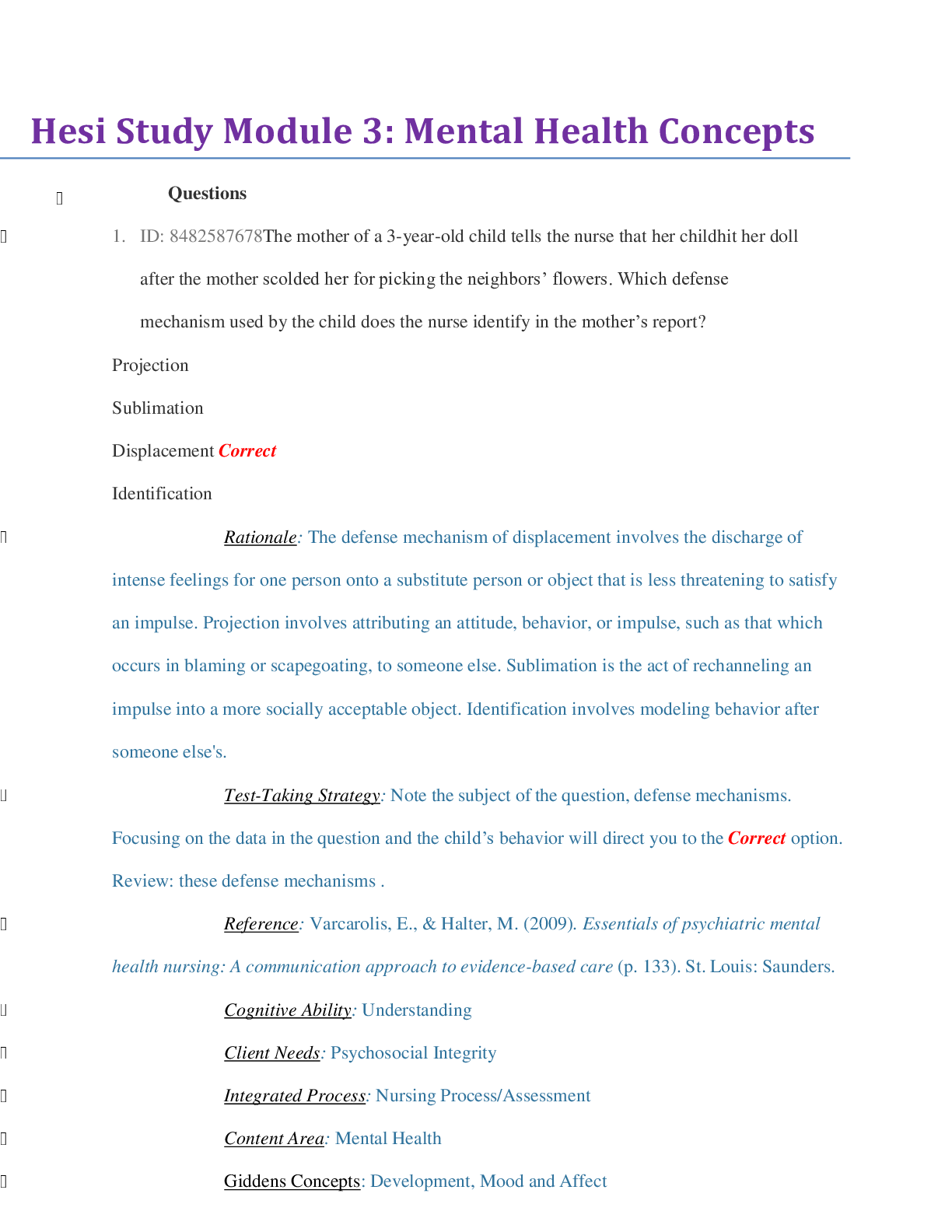
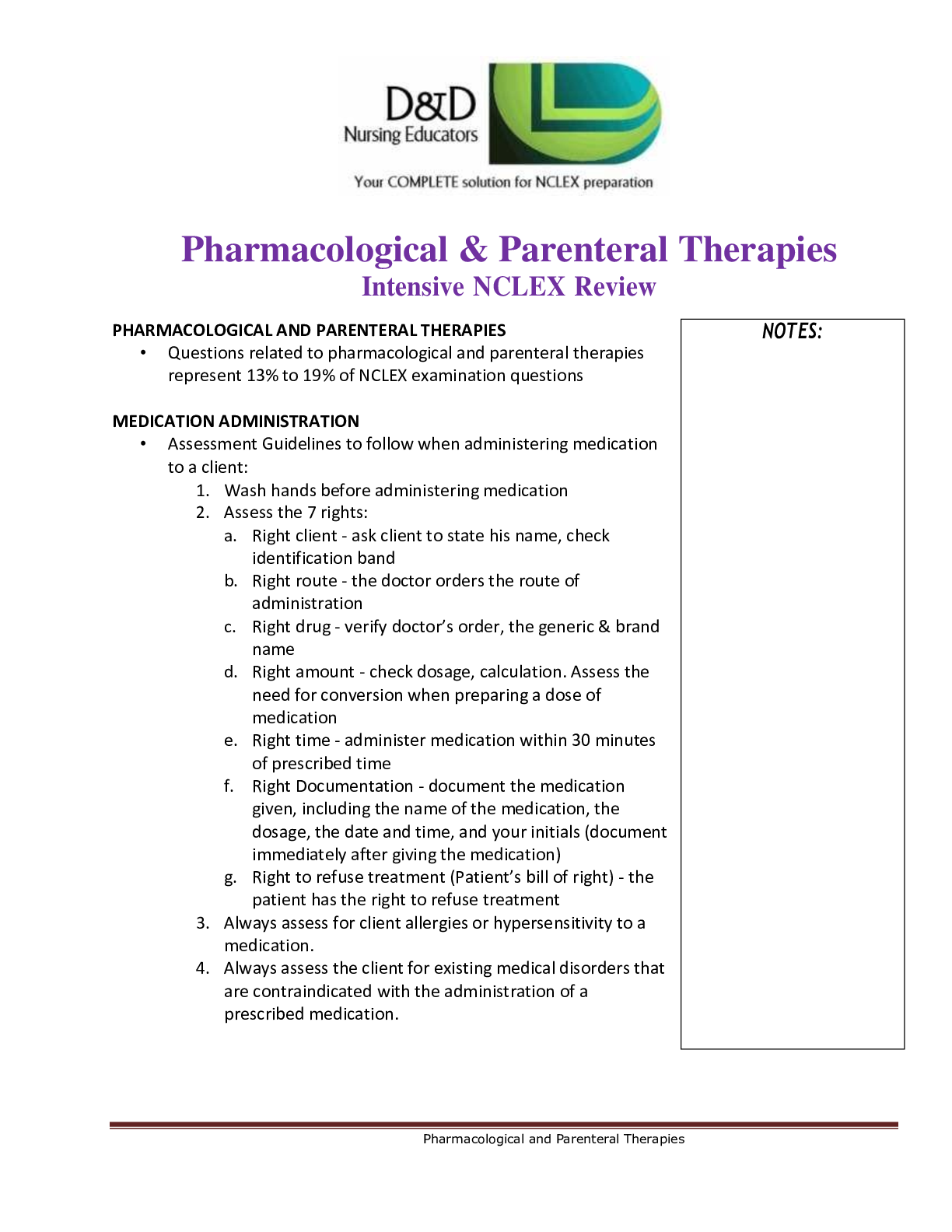
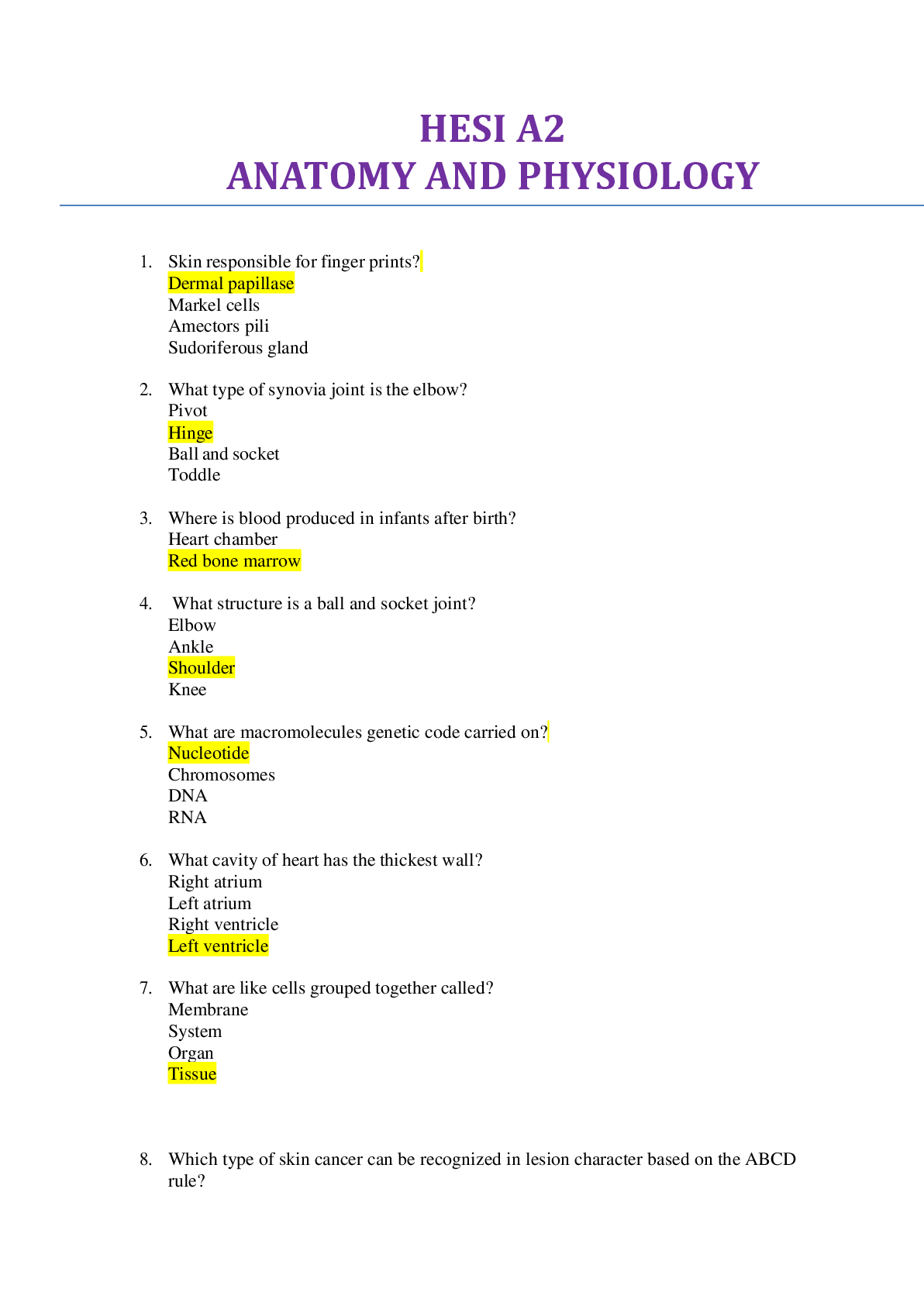
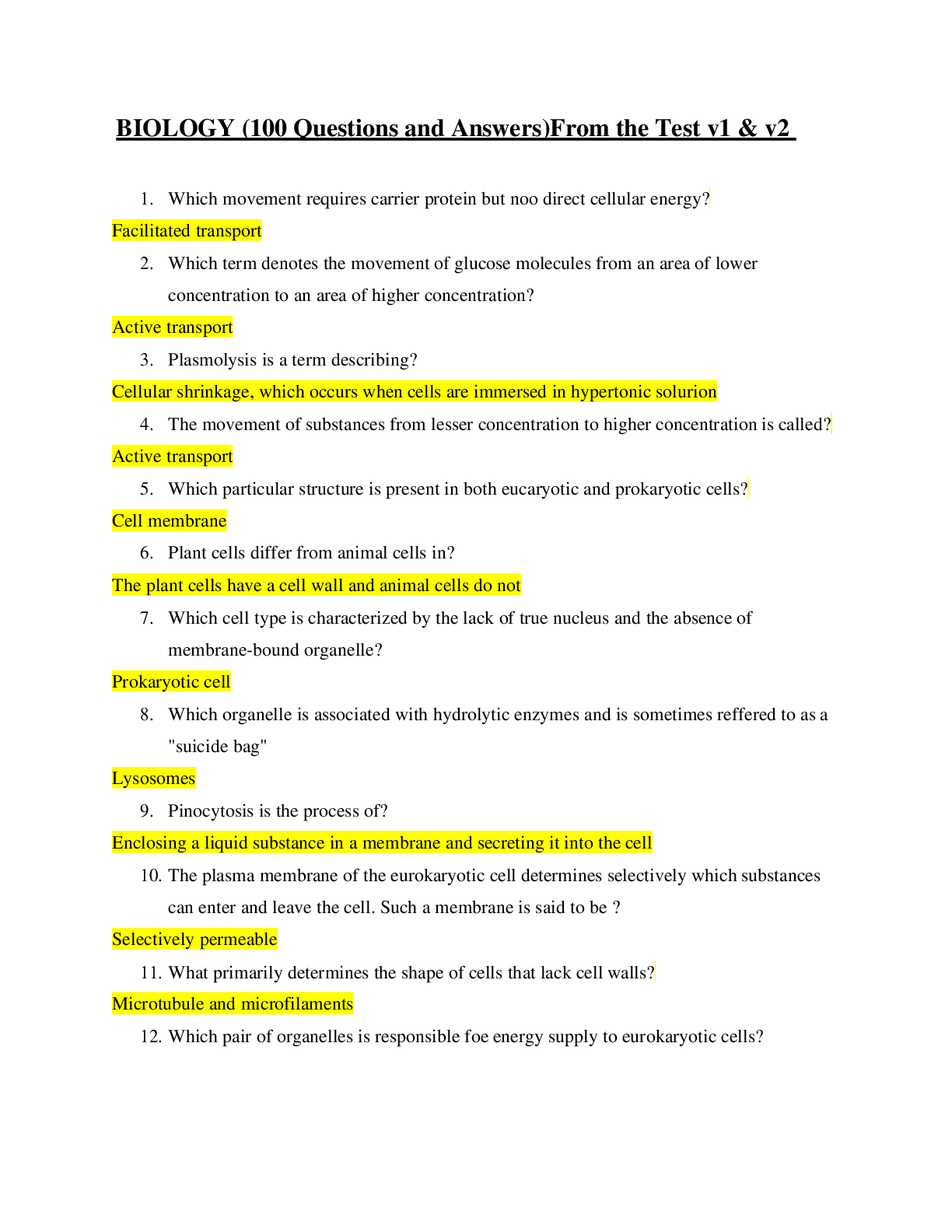
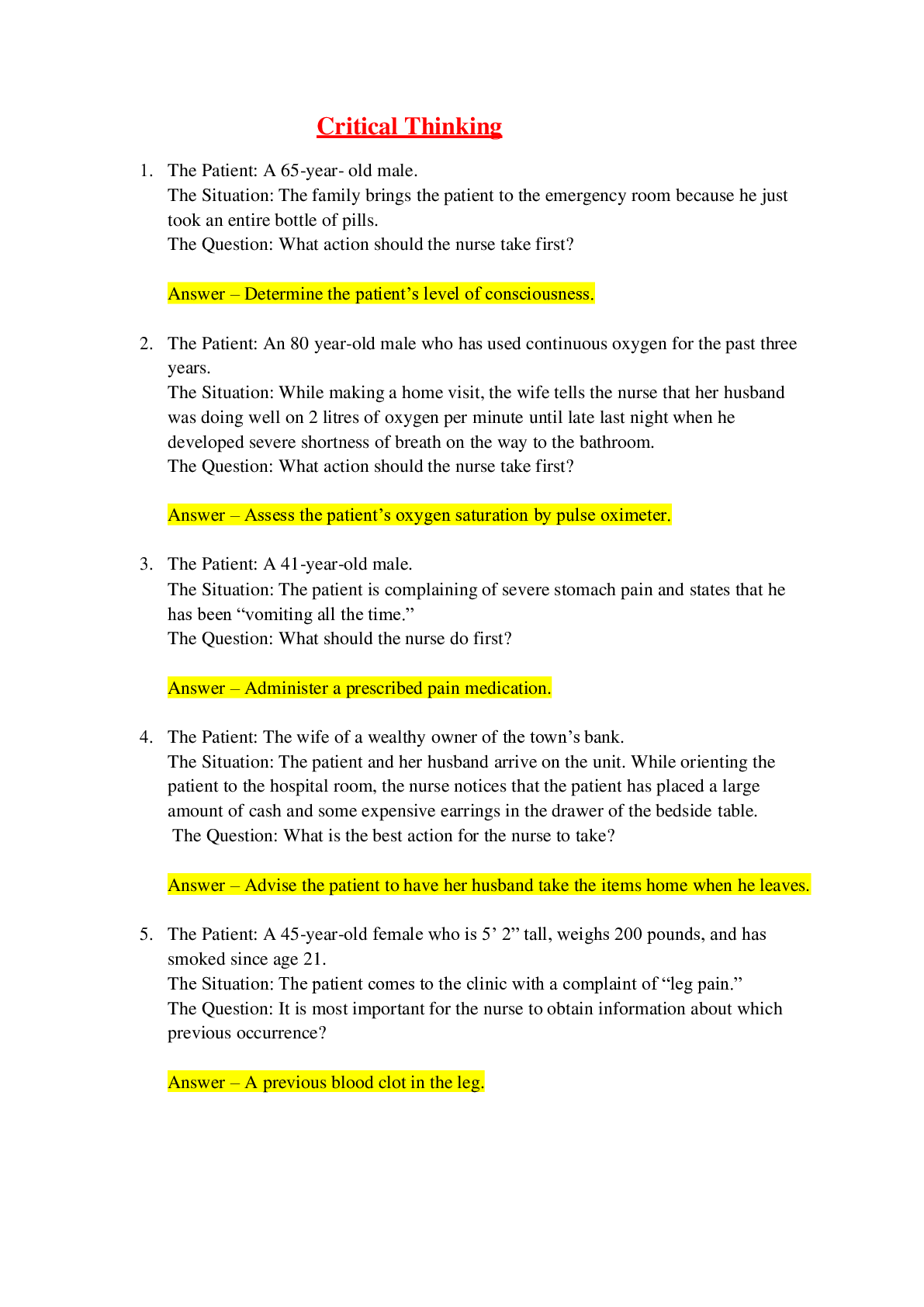
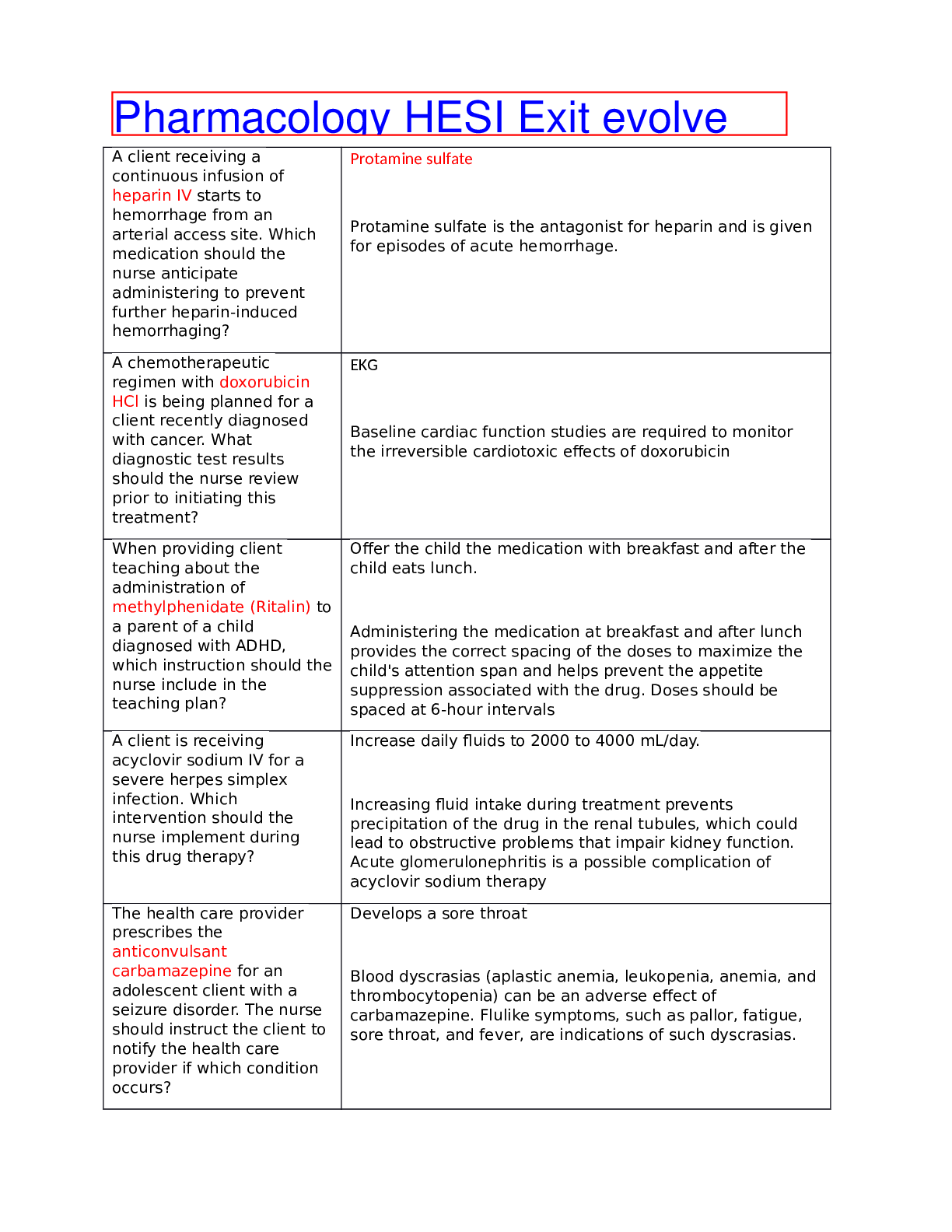
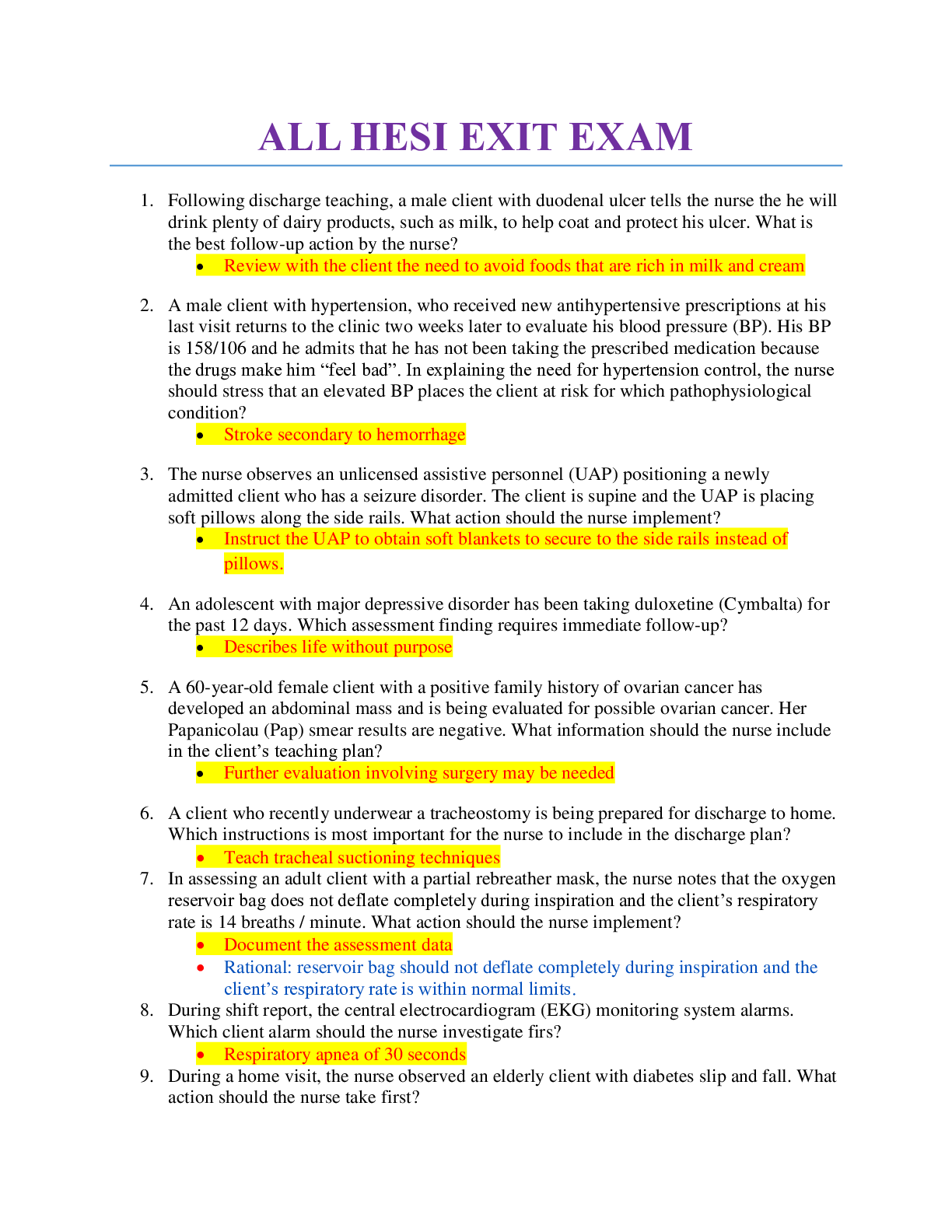






 (1).png)



